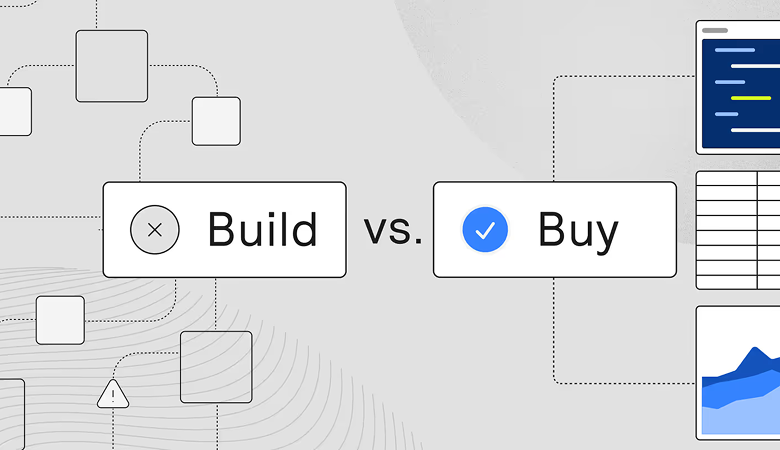What are SaaS metrics and KPIs?
SaaS metrics are quantifiable data points that measure various aspects of a SaaS business, while SaaS KPIs (key performance indicators) are the most critical of these metrics, chosen to track progress towards specific business goals and assess overall health.
Metrics provide raw data, and KPIs turn these into actionable insights by linking them to strategic outcomes. Do keep in mind that they can be used interchangeably.
These are the SaaS KPIs and metrics we’ll cover:
- Monthly recurring revenue (MRR)
- Annual recurring revenue (ARR)
- Customer acquisition cost (CAC)
- Customer lifetime value (LTV)
- Gross margin
- Net revenue retention (NRR)
- Gross revenue retention (GRR)
- Annual contract value (ACV)
- Total contract value (TCV)
- Burn rate
- Churn rate
- Customer retention rate
- Net promoter score (NPS)
- Customer satisfaction score (CSAT)
- Customer health score
- Average revenue per user (ARPU)
- Expansion revenue
- Revenue churn rate
- Monthly unique visitors
- Customer lifetime value to CAC ratio (LTV:CAC)
- Lead-to-customer conversion rate
- Qualified lead velocity rate (LVR)
- Organic vs. paid traffic
- Trial conversion rate
- Marketing qualified leads (MQLs)
- Sales qualified leads (SQLs)
- Sales cycle length
- Activation rate
- Product usage frequency
- Feature adoption rate
- User retention rate
- Customer engagement score
- Customer support ticket volume
- First response time
- Resolution time
Why are they important in SaaS companies?
They are particularly vital for SaaS businesses because the recurring revenue model presents unique characteristics:
- Customer acquisition requires upfront investment with returns realized over time, making it important to monitor the cost of acquiring customers (CAC) against their long-term value (LTV).
- Customer retention is vital. As revenue is subscription-based, losing customers (churn) directly impacts future earnings and sustainability.
- Consistent monthly or annual revenue (MRR/ARR) is the core of the business model, demanding close tracking for forecasting and growth assessment.
- Understanding how engaged customers are with the product is key to reducing churn and identifying opportunities for upselling or cross-selling, influencing average revenue per user (ARPU) and expansion revenue.
- The ability to scale rapidly requires keeping a close eye on growth-related metrics like lead velocity rate (LVR) and conversion rates at different stages of the customer journey.
- Customer satisfaction and loyalty are indicators of retention and future growth. They are measured through metrics like net promoter score (NPS) and customer satisfaction score (CSAT).
Note: Want to dive deeper into the essential metrics that fuel SaaS growth? Be sure to check out our blog article on SaaS growth metrics.
Financial metrics
Financial metrics help understand the monetary health and sustainability of any SaaS business. These SaaS KPIs provide insights into revenue generation, cost management, and overall profitability. Let's dive into each key financial metric.
1. Monthly recurring revenue (MRR)
MRR represents the predictable revenue a SaaS company expects to get every month from its active subscriptions. As one of the most fundamental SaaS KPIs, it’s crucial for gauging the consistent income generated by the firm.
How do you calculate MRR?
Formula: MRR = Number of paying customers * Average revenue per customer per month
MRR can be calculated by multiplying the number of paying users by the average revenue per user per month. For customers with different subscription tiers, you would sum the monthly revenue from each customer.
This example calculation illustrates how to calculate MRR:
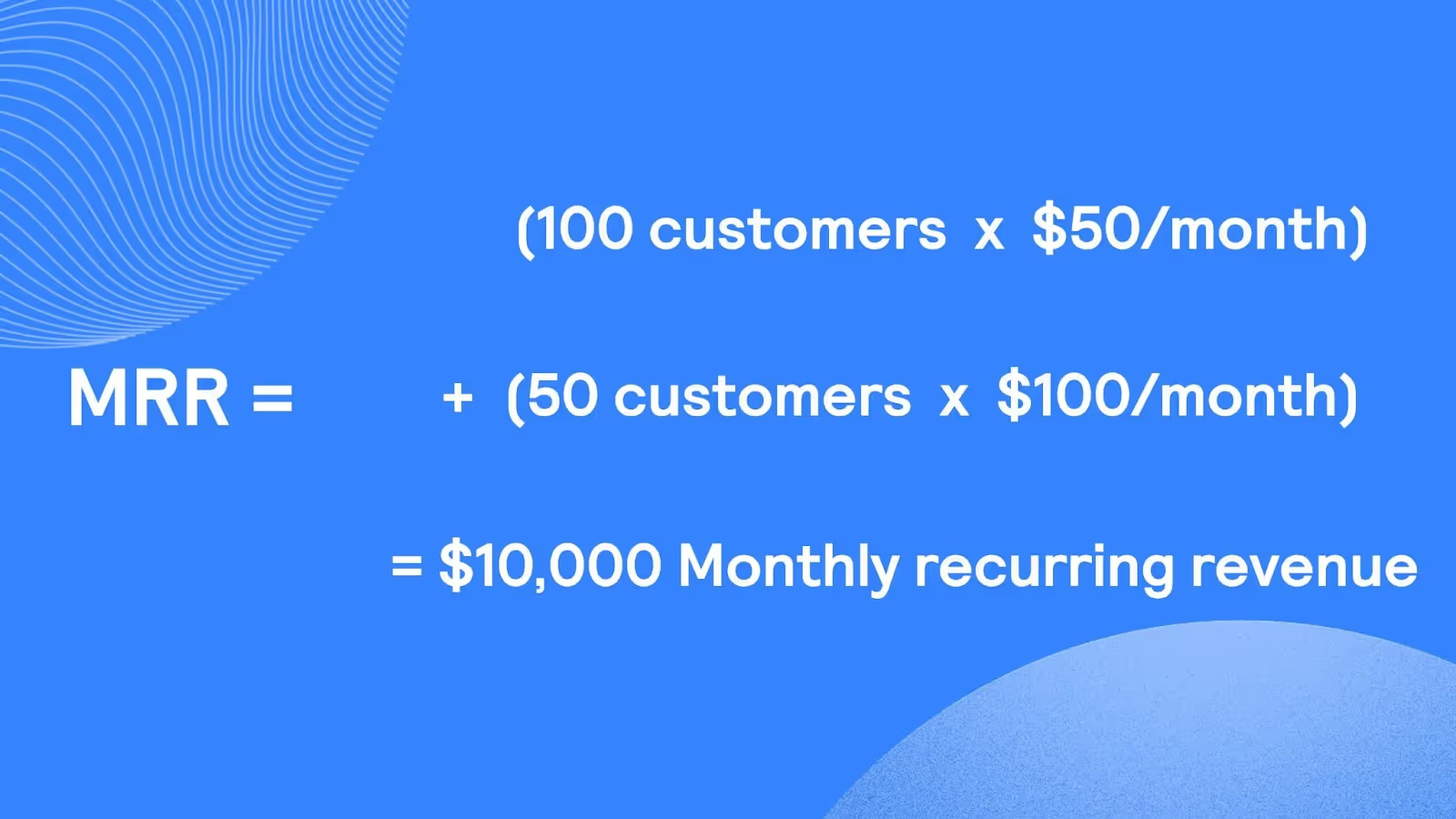
2. Annual recurring revenue (ARR)
ARR is the annualized value of your recurring revenue — it’s your MRR multiplied by 12. For effective long-term financial planning, ARR is among the most important SaaS KPIs, providing a broader view of your subscription revenue trajectory.
How do you calculate ARR?
Formula: ARR = MRR * 12
ARR is calculated by multiplying your MRR by 12. Alternatively, if you primarily have annual contracts, you can sum the total value of all active annual contracts.
This example shows how to calculate ARR:
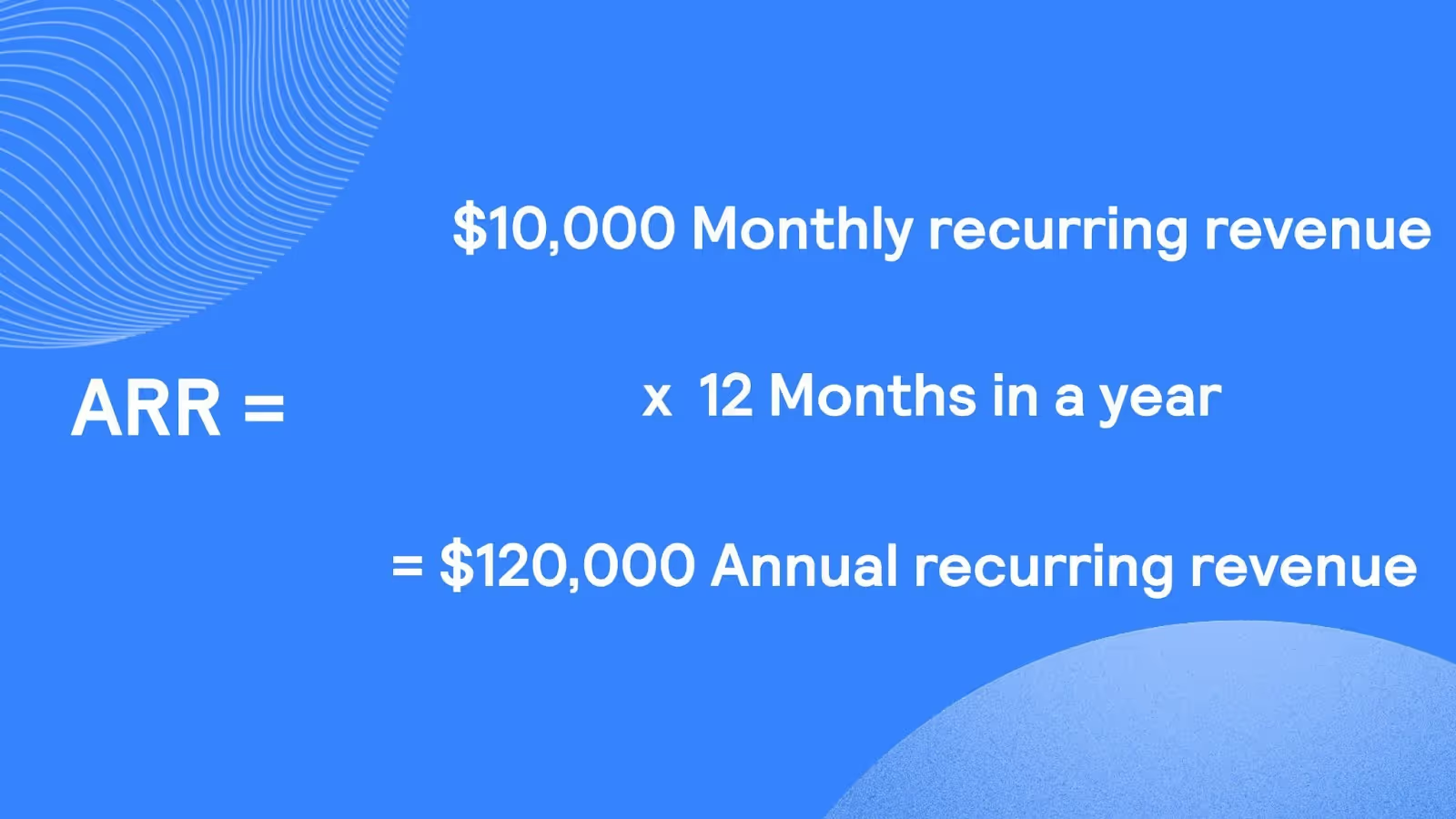
Note: For more on MRR vs. ARR, read our blog post explaining each metric in more detail.
3. Customer acquisition cost (CAC)
CAC represents the total cost a SaaS company incurs to acquire a new paying customer. Understanding CAC is vital for assessing the efficiency of your customer acquisition efforts, making it one of the most important SaaS KPIs to watch.
Components contributing to CAC include:
- Marketing expenses (advertising, content creation, SEO)
- Sales team salaries and commissions
- Sales and marketing tools and software
- Overhead costs associated with sales and marketing
Strategies to improve your CAC:
- Implement targeted marketing: Instead of broad campaigns, focus on specific customer segments most likely to convert. Think refining buyer personas and tailoring content and ad messaging.
- Enhance lead qualification: Make sure your marketing and sales teams are aligned on what constitutes a qualified lead to avoid wasting resources on unlikely prospects. Implement lead scoring based on engagement and demographics.
- Make onboarding easier: A smooth and effective onboarding can lead to higher conversion rates from free trials or freemium users. Focus on getting users to their "aha!" moment quickly.
- Optimize your pricing strategy: Experiment with different pricing tiers and models to find the sweet spot that maximizes customer acquisition while maintaining profitability. Consider tiered pricing or usage-based models.
- Use content marketing and SEO: Create valuable content that attracts organic traffic and leads over time, reducing reliance on paid advertising. Focus on keywords your target audience searches for.
4. Customer lifetime value (LTV)
LTV predicts the total revenue a SaaS company can expect to earn from a single user over the entire duration of their relationship. As one of the more forward-looking SaaS KPIs, it provides a long-term perspective on customer profitability.
How do you calculate LTV?
Formula: LTV = Average revenue per account (ARPA) / Customer churn rate
For example, see this hypothetical scenario to demonstrate the LTV calculation:
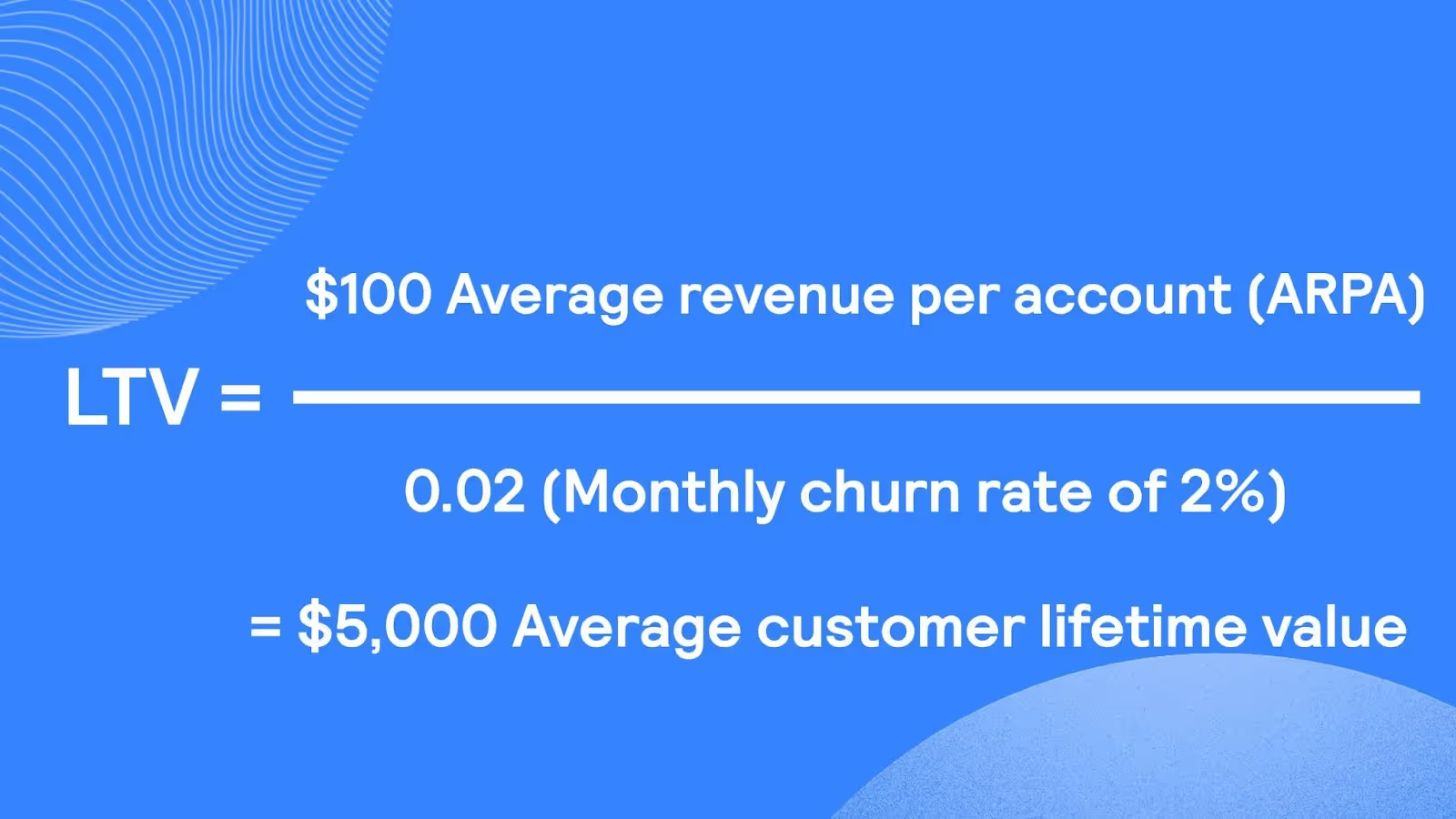
How do you balance LTV with CAC?
A healthy SaaS business typically has an LTV higher than its CAC. The ideal LTV:CAC ratio is often cited as 3:1 or greater. If your CAC is higher than your LTV, you are spending more to acquire customers than they are worth.
Balancing these SaaS KPIs involves focusing on strategies to increase LTV (e.g., improving retention, upselling) and decrease CAC (as mentioned in the previous section).
5. Gross margin
Gross margin is the percentage of revenue remaining after deducting the direct costs of making and delivering your SaaS product. It indicates the profitability of your core offering and is a key financial SaaS KPI.
How do you calculate your gross margin?
Formula: Gross margin = (Total revenue - Cost of goods sold (COGS)) / Total revenue * 100%
For a SaaS business, COGS typically includes hosting fees, customer support costs directly tied to service delivery, and other expenses directly related to providing the software.
This example scenario shows how to calculate your gross margin:
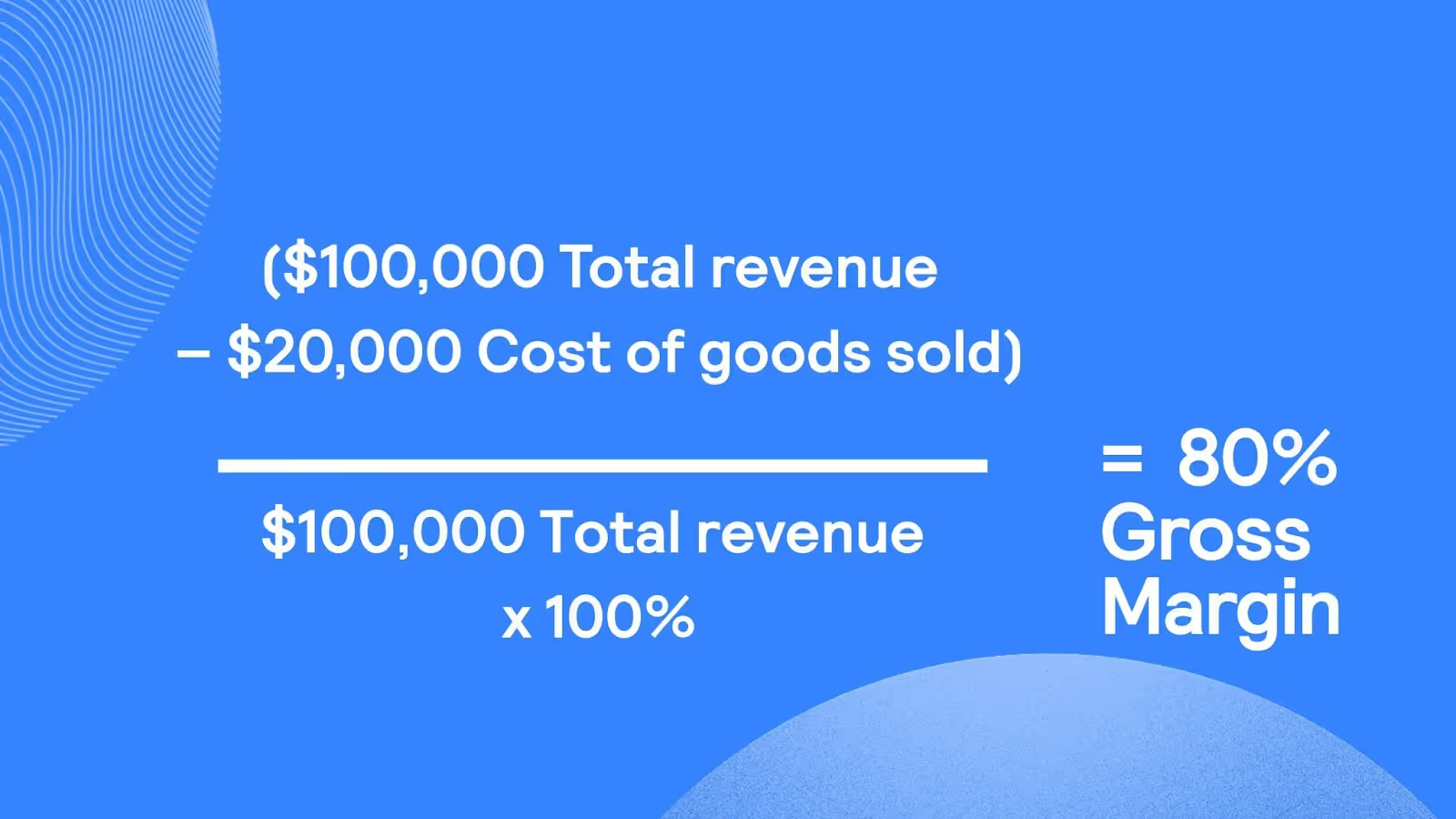
Here are some tips for improving your gross margin:
- Monitor and optimize hosting and infrastructure costs.
- Improve product delivery and support processes.
- Negotiate better rates with vendors.
- Increase pricing where possible without increasing churn significantly.
6. Net revenue retention (NRR)
NRR measures the percentage of recurring revenue retained from existing customers over a period, taking into account upgrades, downgrades, and churn. It is a crucial indicator of sustainable growth and one of the most watched SaaS KPIs.
How do you calculate NRR?
NRR is calculated using the following formula:
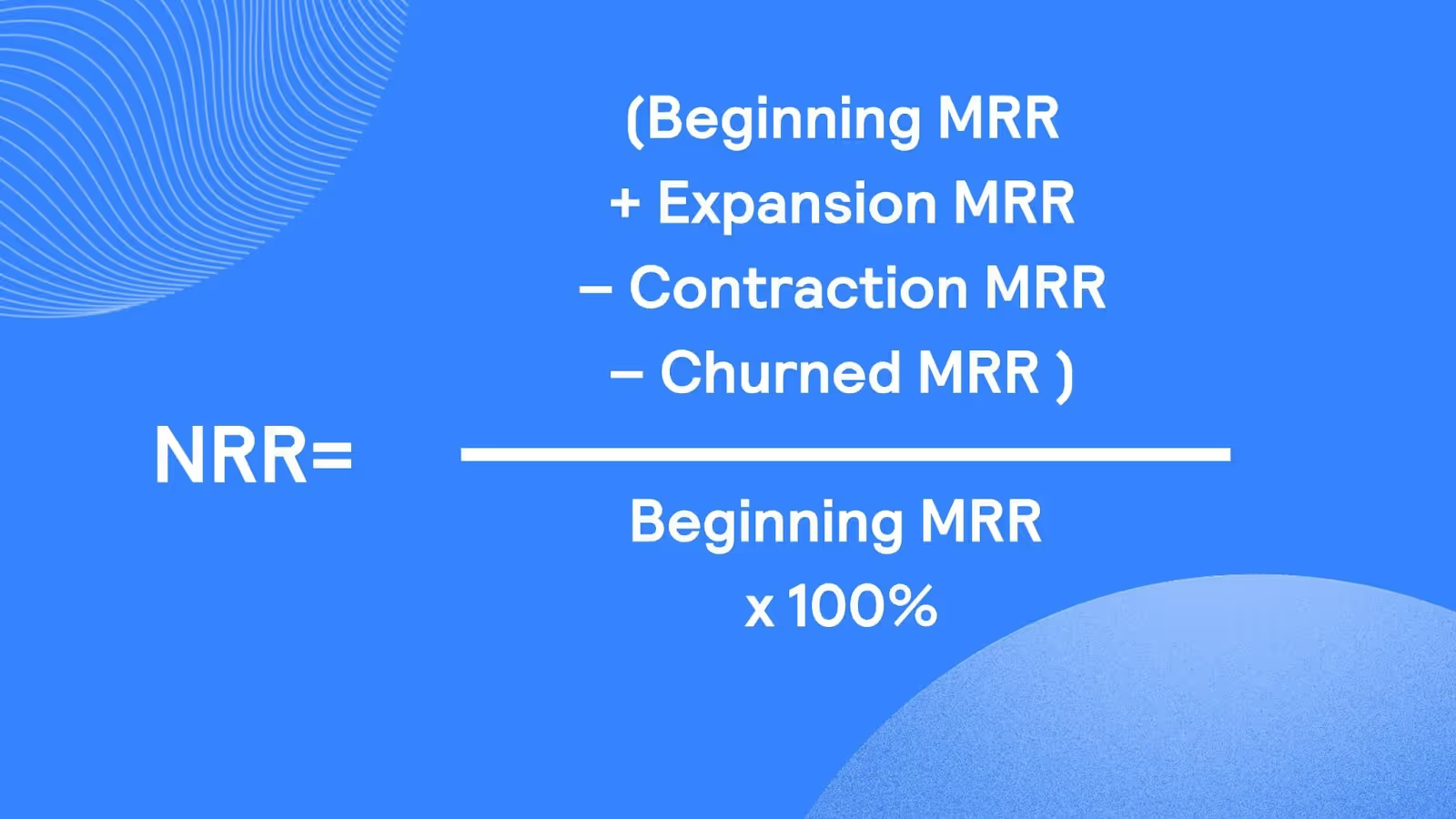
An NRR greater than 100% indicates that your existing customer base is generating more revenue over time through upgrades and expansions than you are losing through downgrades and churn, highlighting the power of this SaaS KPI.
7. Gross revenue retention (GRR)
GRR measures the percentage of recurring revenue retained from existing customers without considering expansion revenue. It focuses purely on losses from churn and downgrades. GRR provides a clearer picture of your core retention performance compared to NRR.
How do you calculate your GRR?
The formula looks like this:
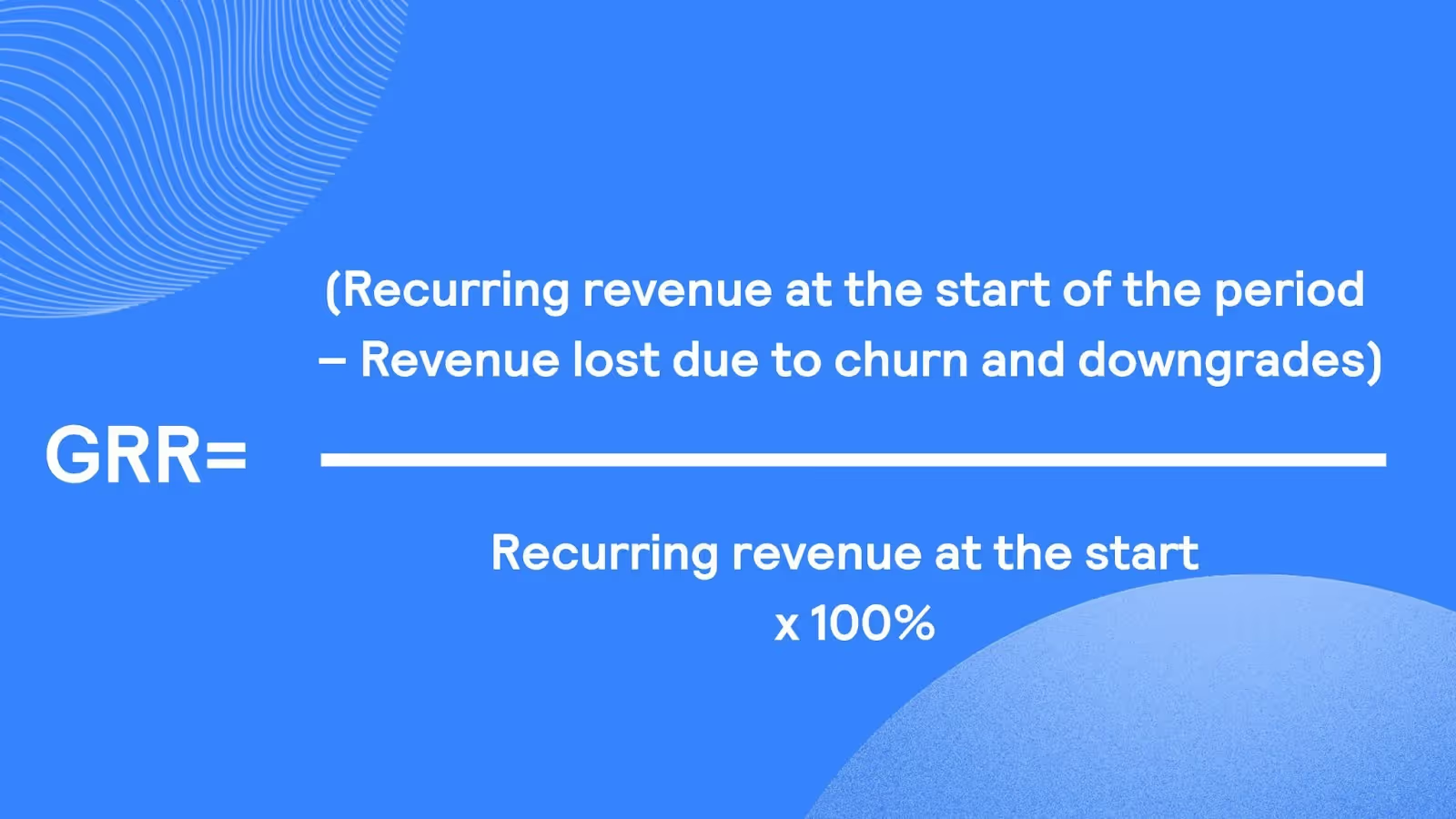
For example, if you started the month with $100,000 in recurring revenue and lost $5,000 due to churn and downgrades, your GRR would be (($100,000 - $5,000) / $100,000) * 100% = 95%.
Quick tips to improve GRR:
- Improve customer onboarding: Make sure new users quickly find value in your product.
- Provide excellent customer support: Address issues promptly and effectively, and be on top of problems with clients, big and small.
- Actively solicit and act on customer feedback: Show customers their opinions matter by also analyzing how users interact with your solution.
- Build strong customer relationships: Foster loyalty and engagement by being transparent both with service offerings and pricing.
- Offer proactive support and engagement: Anticipate customer needs and provide solutions.
Note: Interested in learning more about NRR vs. GRR? Dive deeper into their key differences in our dedicated post.
8. Total contract value (TCV)
TCV is the total value of a customer contract over its entire duration. It includes the ACV plus any one-time fees, such as setup or training costs.
The distinction between ACV and TCV is that TCV provides a holistic view of the total revenue generated from a contract, while ACV focuses on the annualized recurring portion. Both are important when considering overall financial SaaS KPIs.
How do you calculate TCV?
Formula: TCV = Annual contract value (ACV) * Contract length (in years) + One-time fees
Here’s a hypothetical example to show this formula in action:
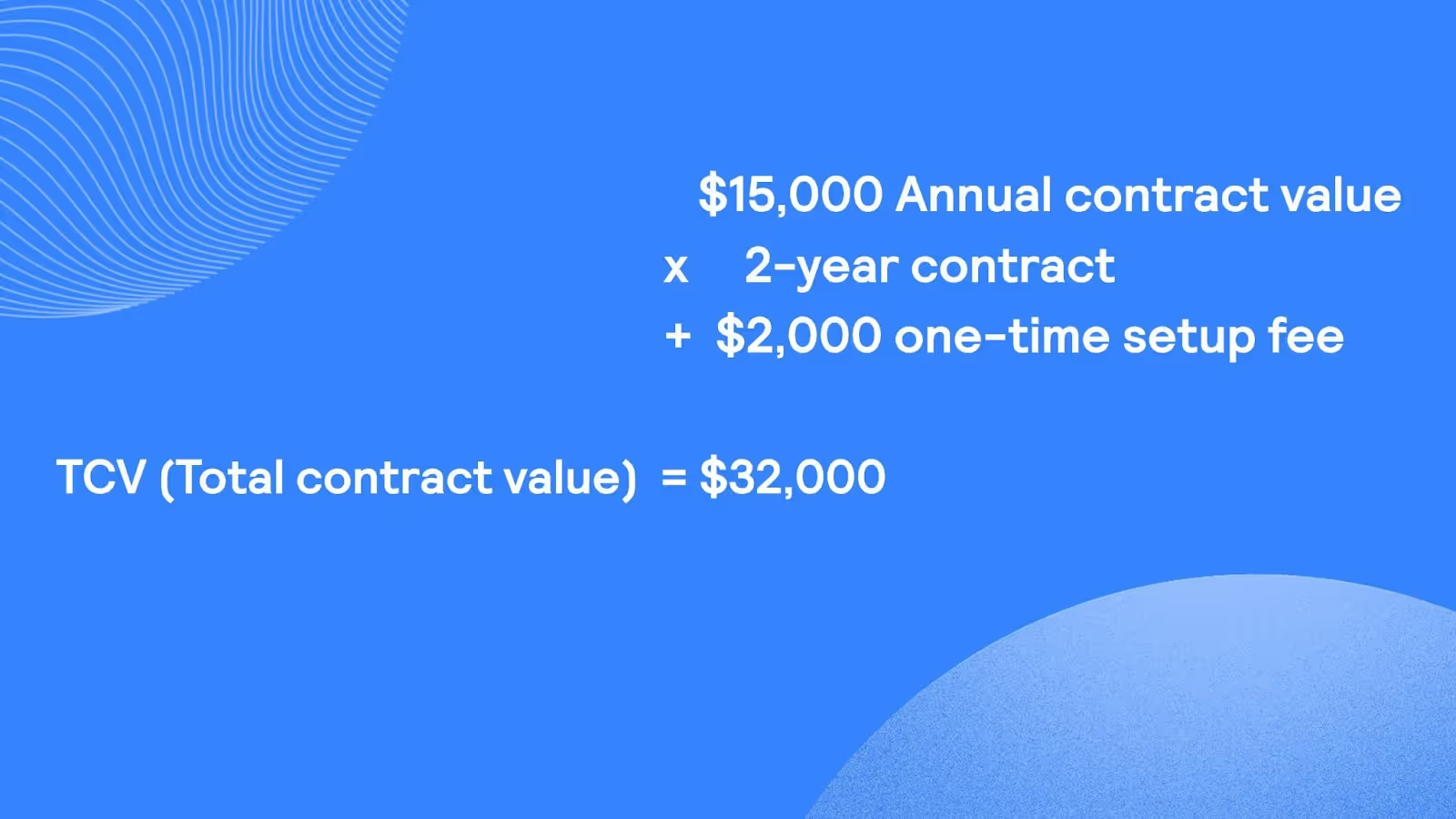
Note: Zoom in on the differences in the calculation of ACV vs. TCV in our in-depth blog post.
9. Annual contract value (ACV)
ACV represents the average revenue generated from a customer contract over a one-year period. It is particularly relevant for SaaS businesses with longer-term contracts and helps in understanding the profitability of those agreements.
How do you calculate ACV?
Formula: ACV = Total contract value / Number of years in contract
ACV is calculated by dividing the total value of a contract by the number of years in the contract.
For example, consider this illustration of calculating ACV:
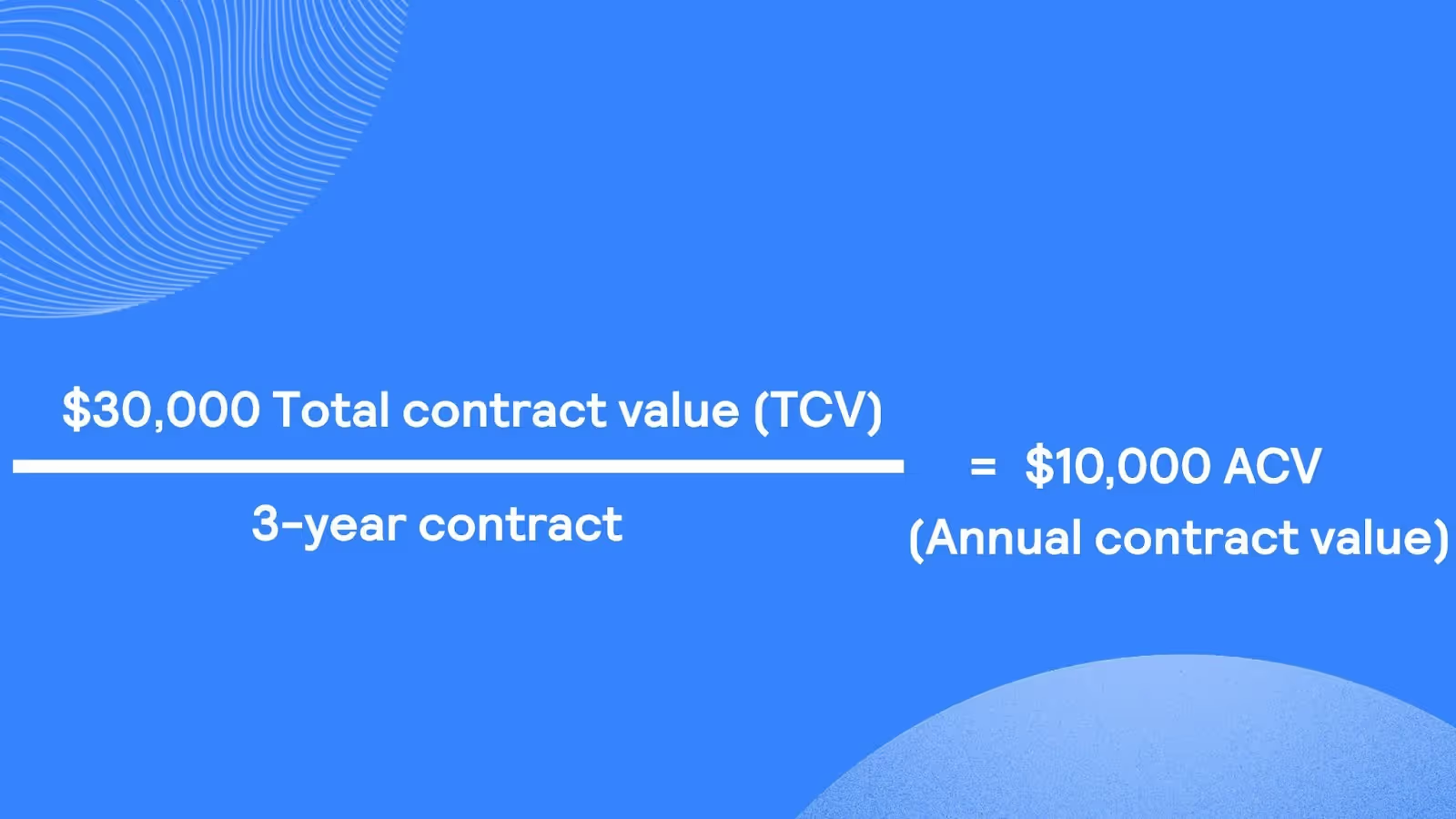
Tracking ACV is one way to analyze the performance indicated by SaaS KPIs.
10. Burn rate
Burn rate is the rate at which a SaaS company is spending its cash reserves, typically measured monthly. It is a critical metric for monitoring cash flow, especially for early-stage companies.
How do you calculate burn rate in SaaS?
Formula: Net burn rate = Total monthly operating expenses - Monthly revenue
Burn rate can be calculated by subtracting the monthly revenue from the total monthly operating expenses.
This example illustrated below shows how to calculate the net burn rate:
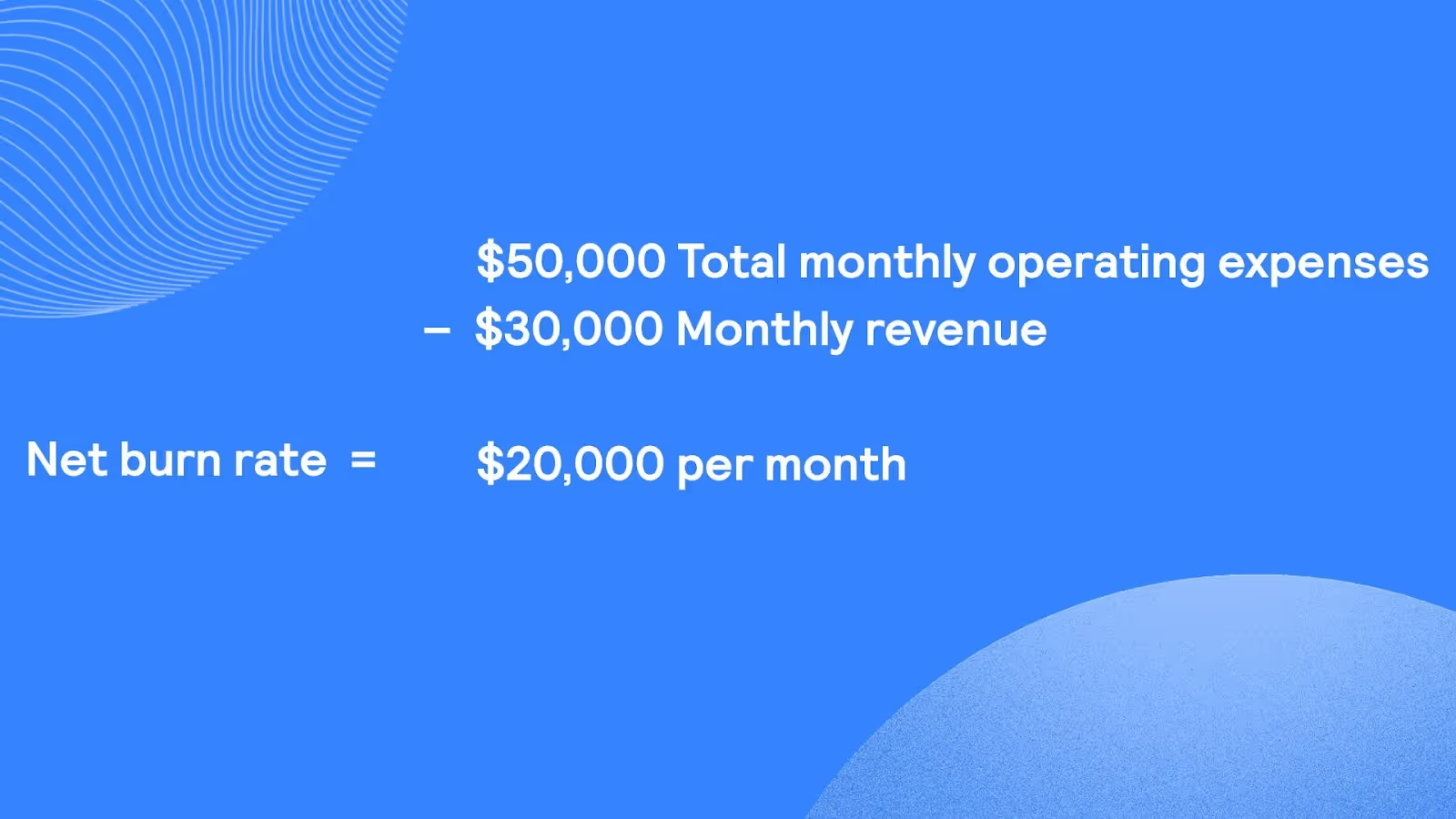
Keep in mind that effective burn rate management involves understanding your runway (how long your cash will last at the current burn rate) and taking steps to either increase revenue or decrease expenses to achieve profitability, a critical aspect of managing SaaS KPIs.
Customer metrics
Customer metrics provide vital insights into your user base, their satisfaction, and their loyalty. These SaaS KPIs are crucial for understanding the health and growth potential of your SaaS business. Let's explore each key customer metric.
11. Churn rate
Churn rate is the percentage of customers who cancel their subscription or do not renew within a specific period.
There are two main types:
- Customer churn focuses on the number of customers lost.
- Revenue churn tracks the amount of recurring revenue lost due to cancellations or downgrades.
A high churn rate impacts growth by eroding your customer base and revenue. Strategies to reduce it include many tips shared above, like improving onboarding, providing top-notch support, and seeking feedback.
How do you calculate your churn rate?
Formula: Churn rate = (Number of customers lost during period / Total number of customers at the start of period) x 100%
For example, this image shows the churn rate formula in action:
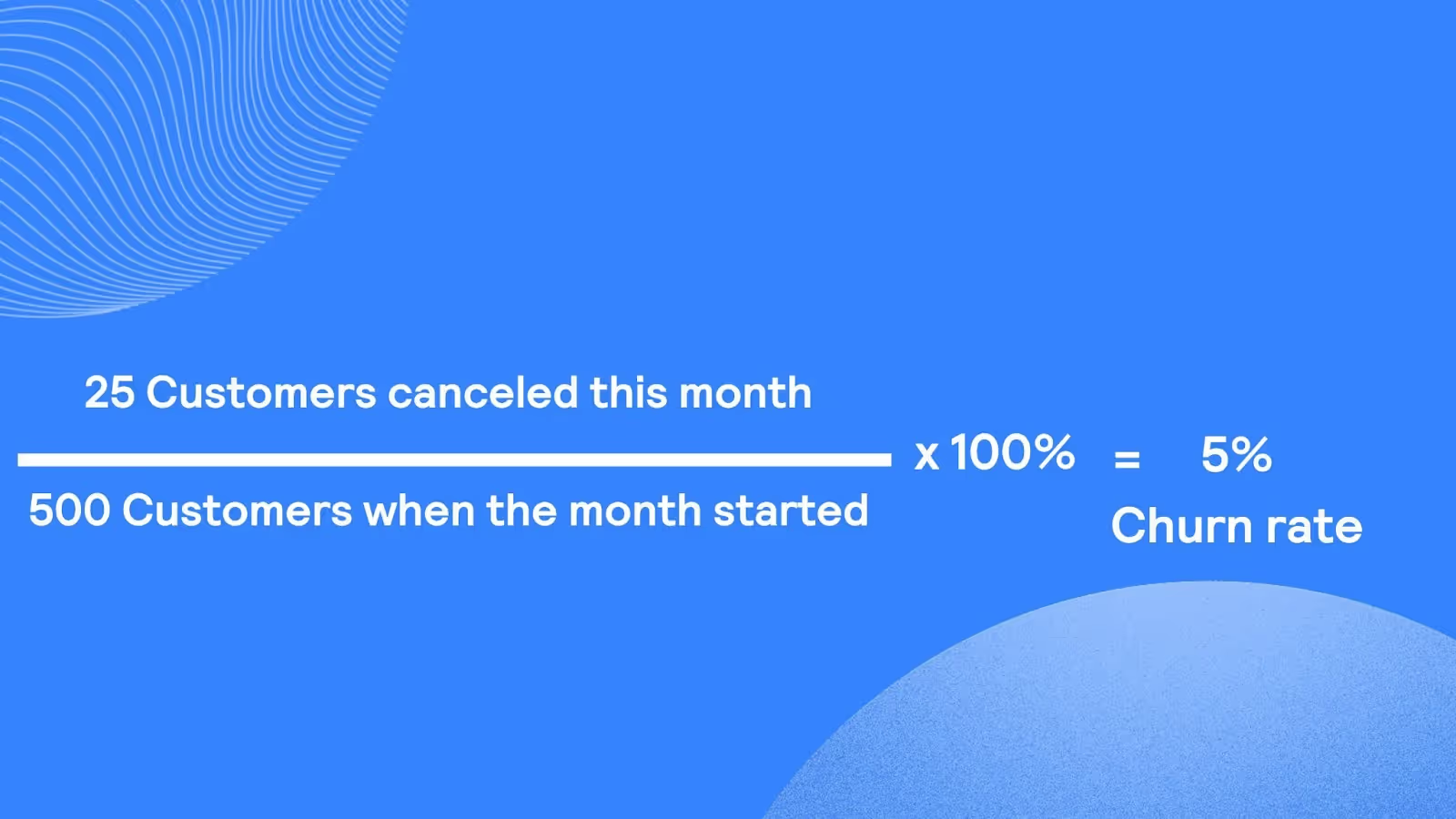
12. Customer retention rate
Customer retention rate measures the percentage of customers who continue to use your product or service over a defined period. It is the inverse of churn and one of the SaaS KPIs that highlights the importance of keeping customers for SaaS sustainability.
Tactics to improve retention rates involve assertive customer engagement, loyalty programs, continuous product improvement based on feedback, and — again — excellent customer service.
How do you calculate your customer retention rate?
Formula: Customer retention rate = ((Number of customers at the end of period - Number of new customers acquired during period) / Number of customers at the start of period) * 100%
For instance, the following illustration shows a hypothetical example of calculating the customer retention rate:
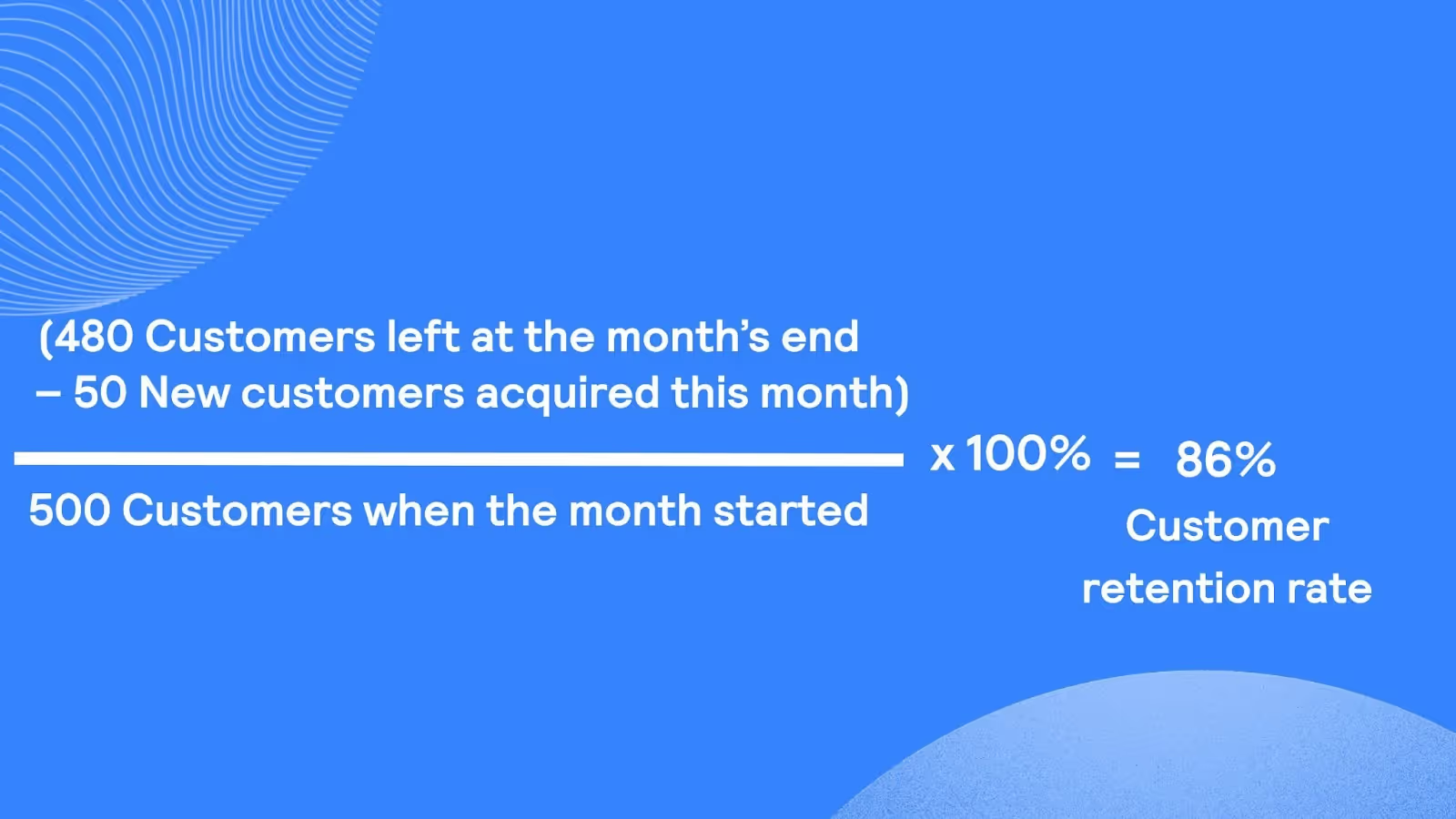
13. Net promoter score (NPS)
NPS is a metric used to measure customer satisfaction and loyalty by asking customers how likely they are to recommend your company, product, or service to others.
Responses are categorized into Promoters (score 9-10), Passives (7-8), and Detractors (0-6). Utilizing NPS feedback can drive product improvements, enhance customer service, and identify areas of dissatisfaction.
14. Customer satisfaction score (CSAT)
CSAT assesses the level of satisfaction customers have with specific interactions, services, or your product overall. Methods to assess CSAT often involve post-interaction surveys asking customers to rate their experience on a scale (e.g., 1-5 or 1-10).
Interpreting CSAT scores helps spot areas needing improvement, and enforcing changes based on CSAT results can lead to higher customer loyalty.
15. Customer health score
Customer health score is a metric that indicates the likelihood of a customer to churn, renew, or upgrade. Indicators of customer health can include product usage frequency, feature adoption, support ticket volume, and engagement levels.
Proactive measures based on health scores allow you to identify at-risk customers and intervene with targeted support or engagement efforts to improve retention.
How do you calculate your customer health score?
Customer health score is often a composite score based on various factors weighted according to their importance for your specific business. You would typically:
- Identify key indicators of customer health.
- Assign weights to each indicator based on its impact on retention and growth.
- Track and score each customer based on these indicators.
- Combine the weighted scores to get an overall health score.
Revenue metrics
Revenue metrics are crucial for tracking the income generation and financial performance of your SaaS business. These SaaS KPIs provide insights into how effectively you are monetizing your user base and driving revenue growth. Let's examine each key revenue metric.
16. Average revenue per user (ARPU)
ARPU represents the average amount of revenue generated from each individual user or account over a specific period, typically monthly. It is significant in revenue analysis as it helps understand the revenue-generating capability of your customer base.
How do you calculate your ARPU?
Formula: ARPU = Total recurring revenue for period / Total number of users or accounts during period
The image below shows an example of how to calculate your average revenue per user:
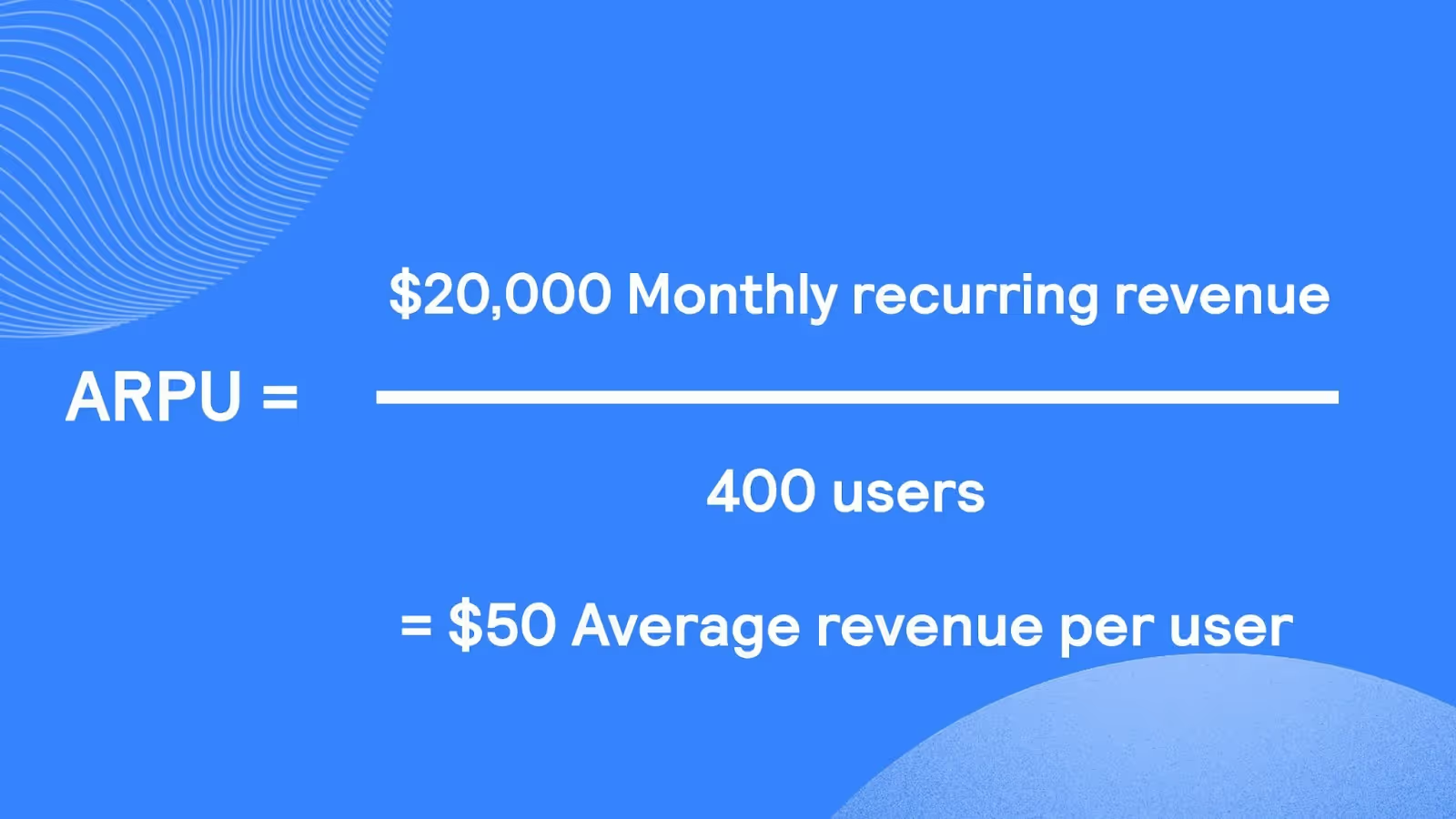
How can you improve your average revenue per user (ARPU)?
Strategies to improve ARPU include:
- Upselling customers to higher-tiered plans
- Cross-selling additional features or services
- Implementing tiered pricing structures
- Strategically increasing prices over time while providing added value
17. Expansion revenue
Expansion revenue is the extra revenue generated from existing customers through upselling (moving to a higher-priced plan) and cross-selling (purchasing additional products or features).
Measuring and maximizing expansion revenue is vital as it is often more cost-effective than acquiring new customers, and especially contributes to revenue growth.
How do you calculate your expansion revenue?
Expansion revenue is typically calculated by summing the revenue generated from upgrades and cross-sells within a period. There isn't a single standard formula, but you would track the MRR or ARR increase from these activities.
18. Revenue churn rate
Revenue churn rate measures the percentage of recurring revenue lost over a specific period due to cancellations or downgrades. Understanding revenue loss over time is vital for assessing the sustainability of your revenue and pinpointing possible issues with customer satisfaction or pricing.
Approaches to minimize revenue churn involve proactive customer success efforts, addressing customer pain points, and offering incentives for retention.
How do you calculate your revenue churn rate?
Formula: Revenue churn rate = (Revenue lost from churned and downgraded customers during period / Total recurring revenue at the start of period) * 100%
For example, the following image demonstrates a calculation of the revenue churn rate in one month:
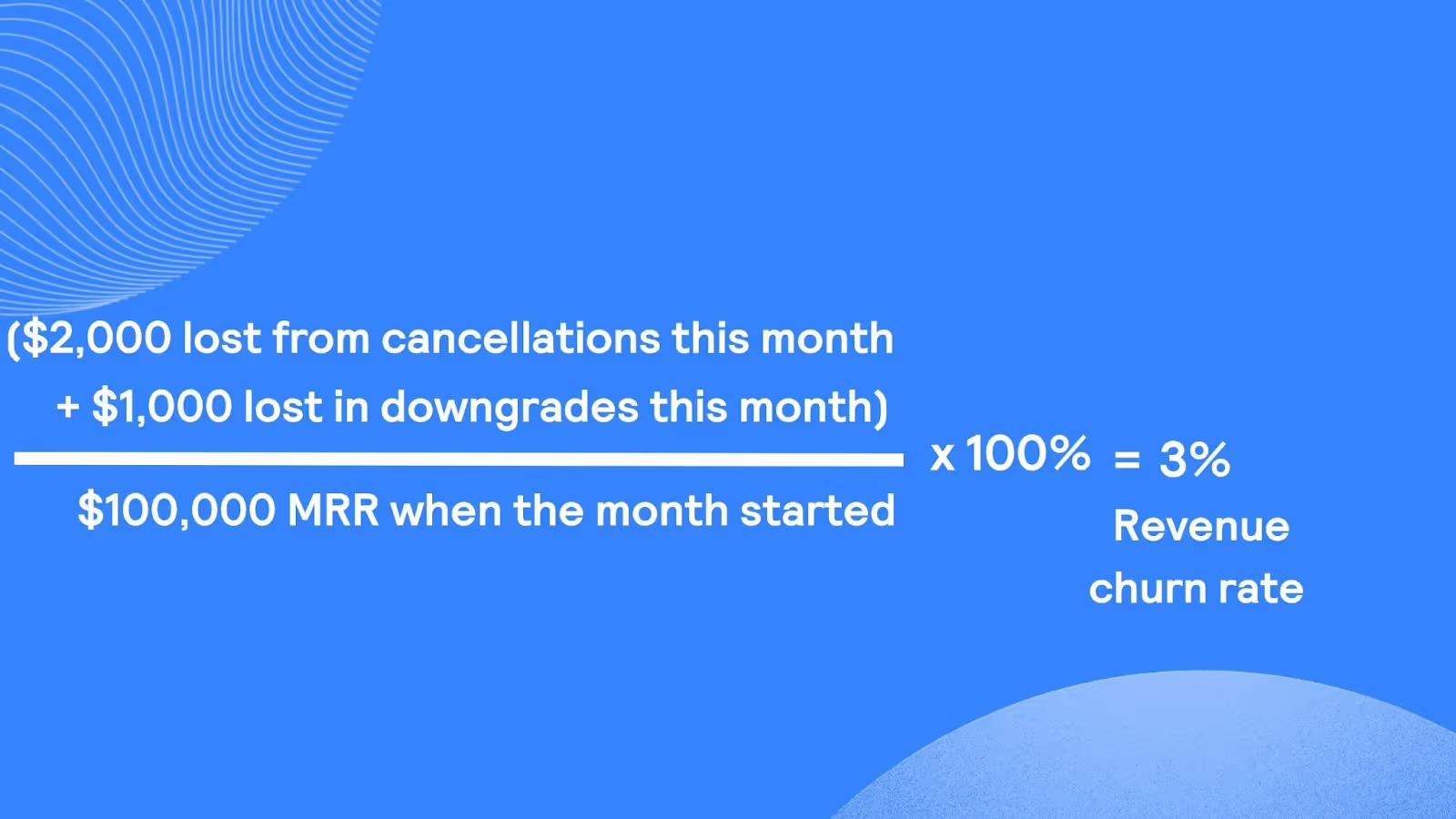
19. Monthly unique visitors
Monthly unique visitors (MUV) tracks the number of distinct individuals who visited your website within a given month. While not direct revenue, it is a key indicator of website traffic, which can be a leading indicator of likely customer acquisition and future revenue.
Converting visitors to paying customers involves sprucing up your website for lead generation and providing clear calls to action.
20. Customer lifetime value to CAC ratio
The LTV:CAC ratio compares the total lifetime value of a customer to the cost of acquiring them. Understanding the efficiency of your customer acquisition spend is crucial for sustainable growth.
Ideal LTV:CAC benchmarks are generally considered to be 3:1 or higher, indicating that the value derived from a customer significantly outweighs the cost of acquiring them.
How do you calculate your LTV:CAC ratio?
Formula: LTV:CAC ratio = Customer lifetime value (LTV) / Customer acquisition cost (CAC)
For example, you can see how to calculate your LTV:CAC ratio in this scenario below:
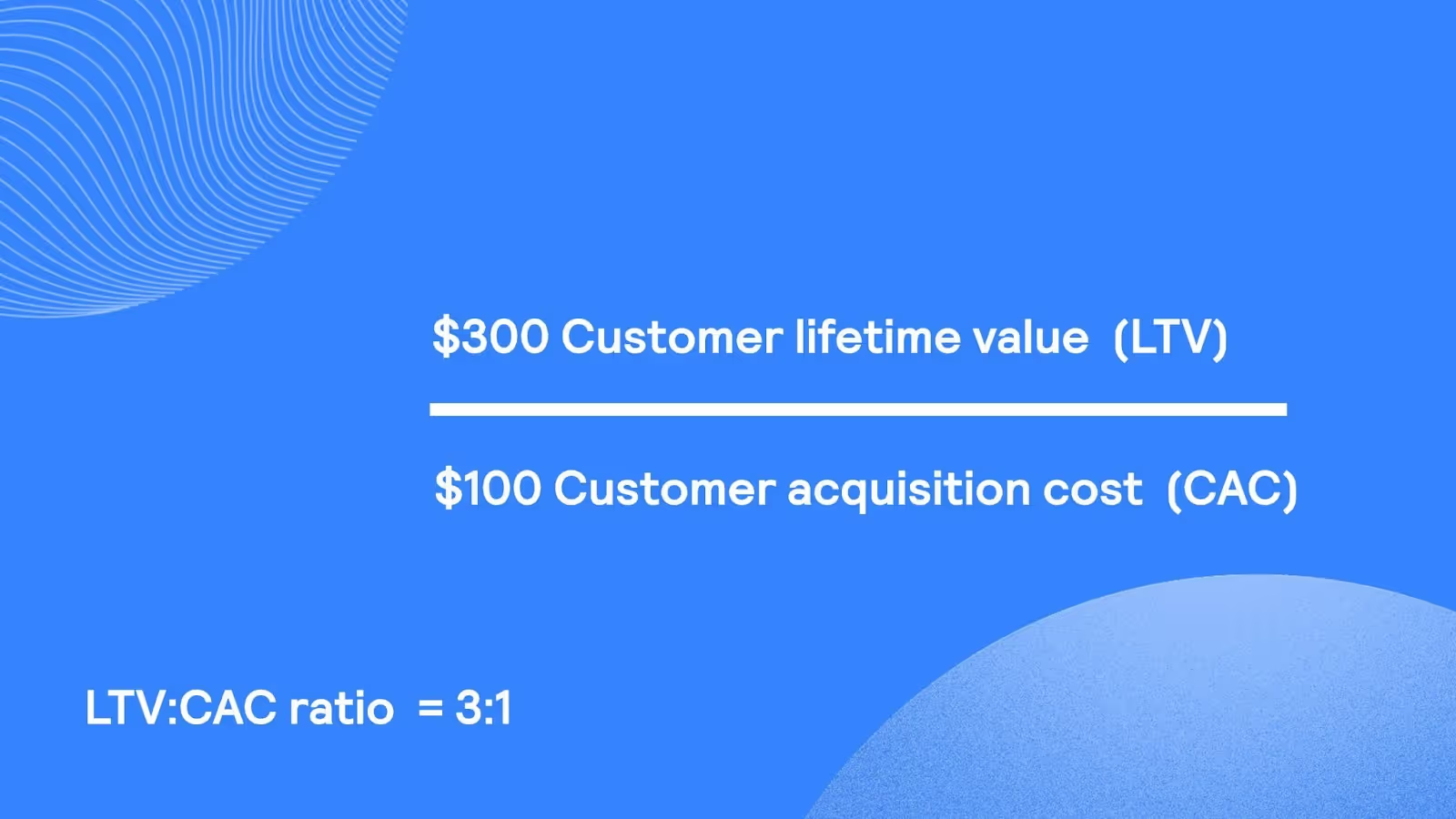
Sales and marketing metrics
Sales and marketing metrics are vital for evaluating the effectiveness of your customer acquisition efforts and your sales processes. Let's examine each key sales and marketing metric.
21. Lead-to-customer conversion rate
Lead-to-customer conversion rate measures the percentage of leads that ultimately become paying customers. Evaluating sales funnel efficiency is the primary significance of this metric. Improving conversion strategies involves making sure each stage of the funnel, from lead generation to closing, is working properly.
How do you calculate your lead-to-customer conversion rate?
Formula: Lead-to-customer conversion rate = (Number of new customers acquired / Total number of leads) * 100%
The example illustrated below shows how to compare your generated leads to paying customers to see your lead-to-customer conversion rate:
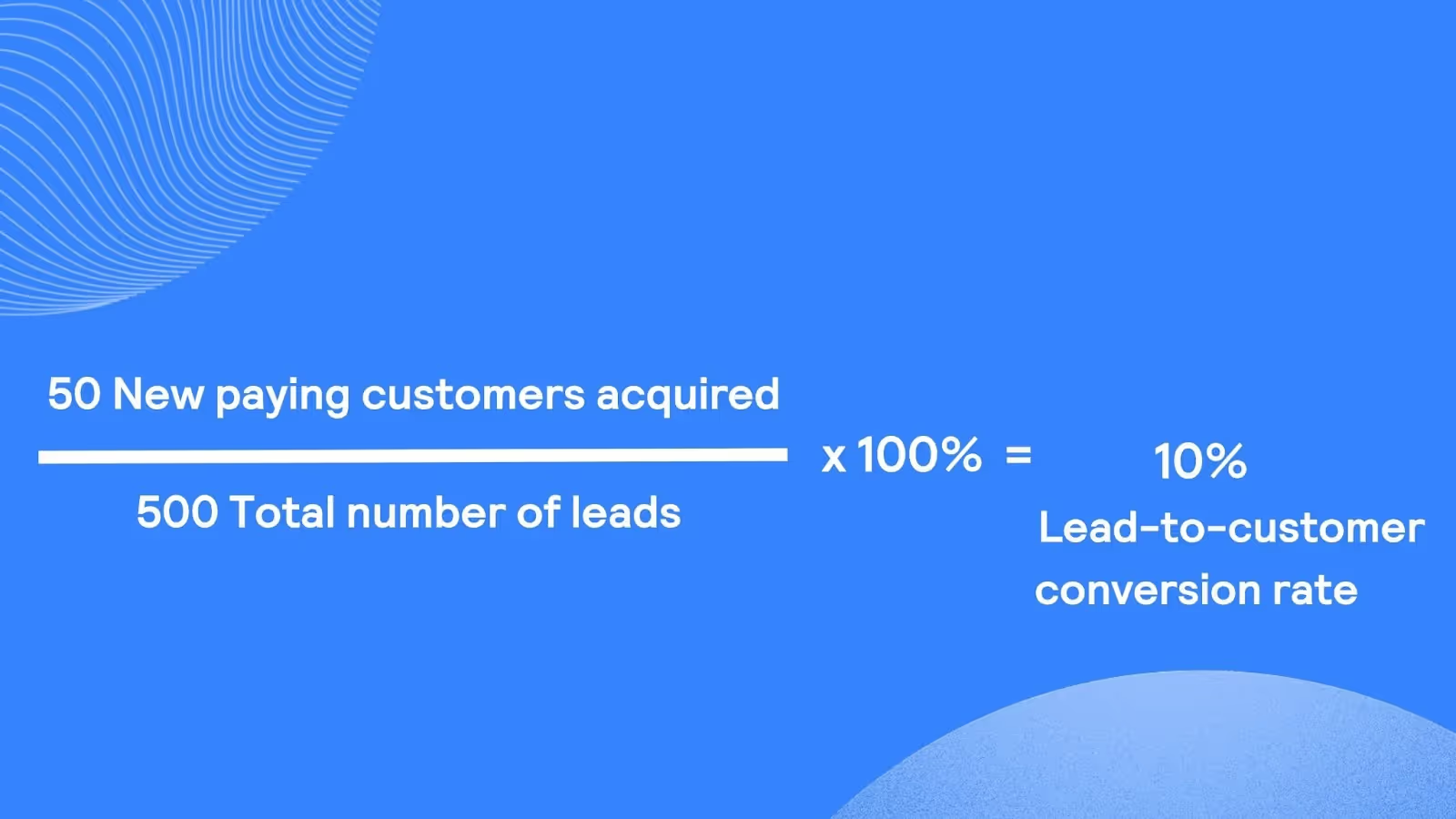
22. Qualified lead velocity rate (LVR)
LVR measures the month-over-month growth rate of your qualified leads. Predicting future sales performance is a key benefit of tracking LVR. Increasing the velocity of qualified leads involves boosting lead generation efforts and improving lead qualification processes.
How do you calculate your qualified lead velocity rate?
Formula: LVR = ((Qualified leads this month - Qualified leads last month) / Qualified leads last month) * 100%
For example, below in this image, you can see how to apply this LVR formula:
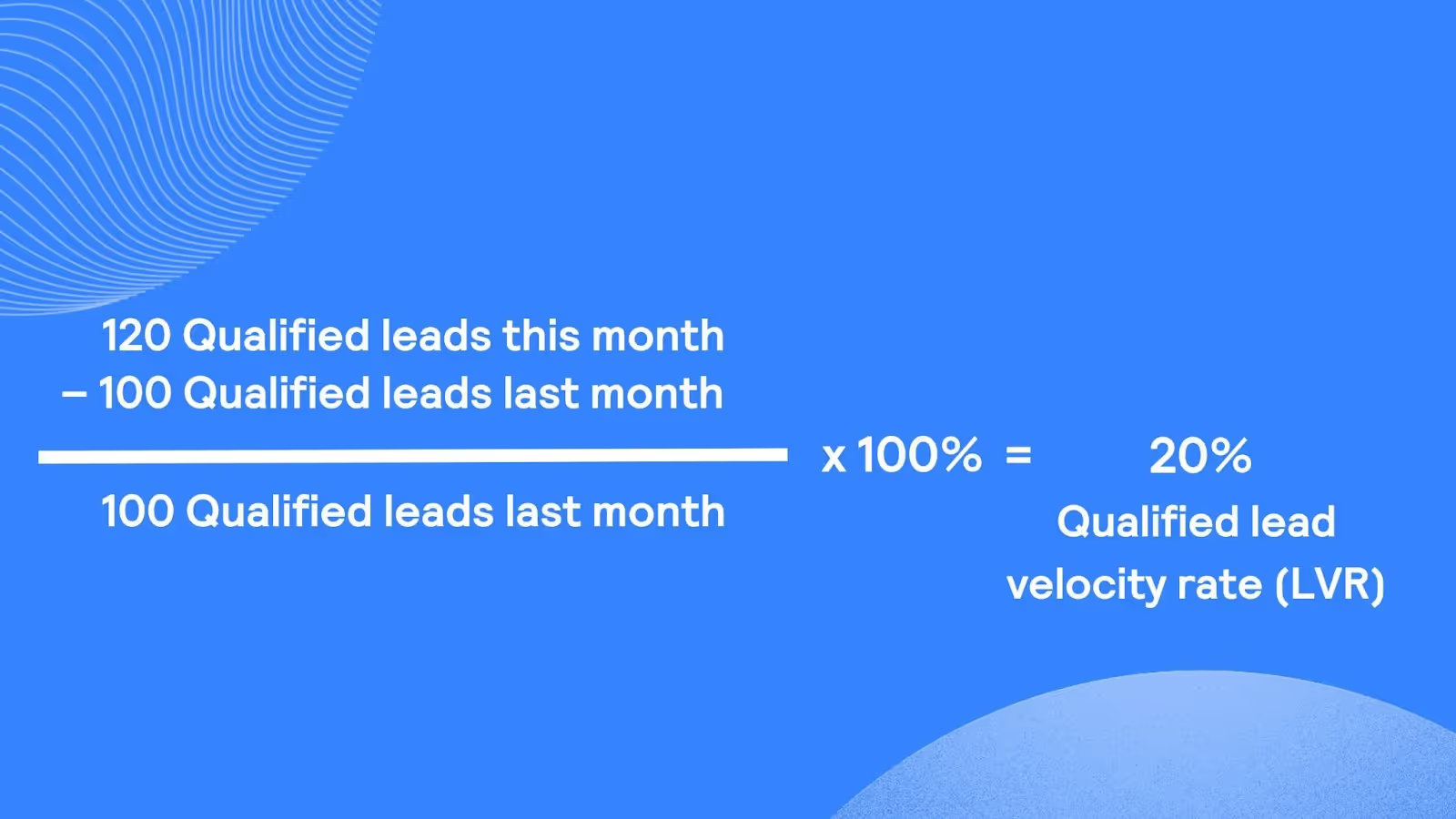
23. Organic vs. paid traffic
Organic traffic refers to visitors who come to your website through unpaid search results, while paid traffic comes from paid advertising campaigns. Analyzing traffic sources helps determine the marketing ROI of different channels. Balancing organic and paid strategies is crucial for sustainable customer acquisition.
How do you calculate your organic vs. paid traffic?
These are typically tracked using web analytics tools like Google Analytics, which provide the volume of traffic from each source. There isn't a specific formula to calculate them, but you would monitor the percentage of total traffic coming from organic versus paid channels.
24. Trial conversion rate
Trial conversion rate measures the percentage of users who sign up for a free trial and subsequently become paying customers. It indicates the efficacy of trial periods in user acquisition.
Techniques to boost trial conversions include improving the trial experience, providing adequate support during the trial, and clearly communicating your SaaS solution’s value proposition.
How do you calculate your trial conversion rate?
Formula: Trial conversion rate = (Number of trial users who converted to paying customers / Total number of trial sign-ups) * 100%
The illustration below shows a hypothetical example of how to calculate your trial conversion rate:
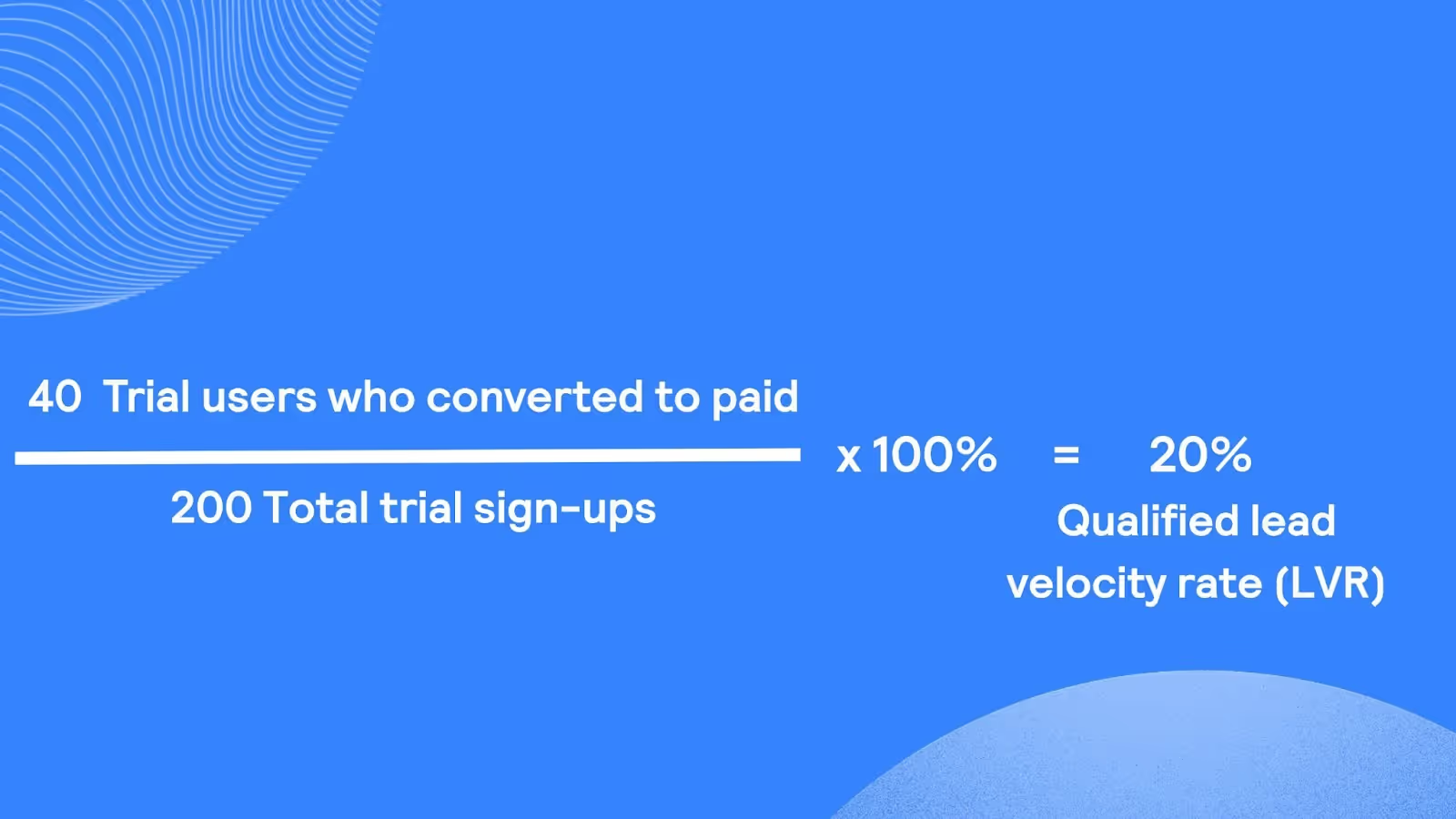
25. Marketing qualified leads (MQLs)
MQLs are leads that have been spotted by the marketing team as having a higher chance of becoming users based on their engagement with marketing efforts. Tracking the volume and quality of MQLs helps evaluate marketing campaign effectiveness.
Improving your MQL generation involves refining targeting, improving content, and putting special attention to your lead-nurturing processes.
26. Sales qualified leads (SQLs)
SQLs are leads that have been further vetted by the sales team and deemed ready for a direct sales engagement. Measuring the number of leads ready for sales engagement helps gauge sales team efficiency.
Keeping your SQL qualification processes in tip-top condition involves clear communication and alignment between marketing and sales on lead criteria.
27. Sales cycle length
Sales cycle length is the average duration it takes for a lead to move through the sales process and become a paying customer. Understanding the duration from lead to customer helps with sales forecasting and identifying bottlenecks.
Strategies to shorten the sales cycle include making the sales process smoother, providing sales enablement resources, and nurturing leads.
How do you calculate your sales cycle length?
Formula: Sales cycle length = Total time taken to close deals / Total number of deals closed
For example, the graphic below shows what the sales cycle length calculation looks like if your team closed 10 deals in 300 days:
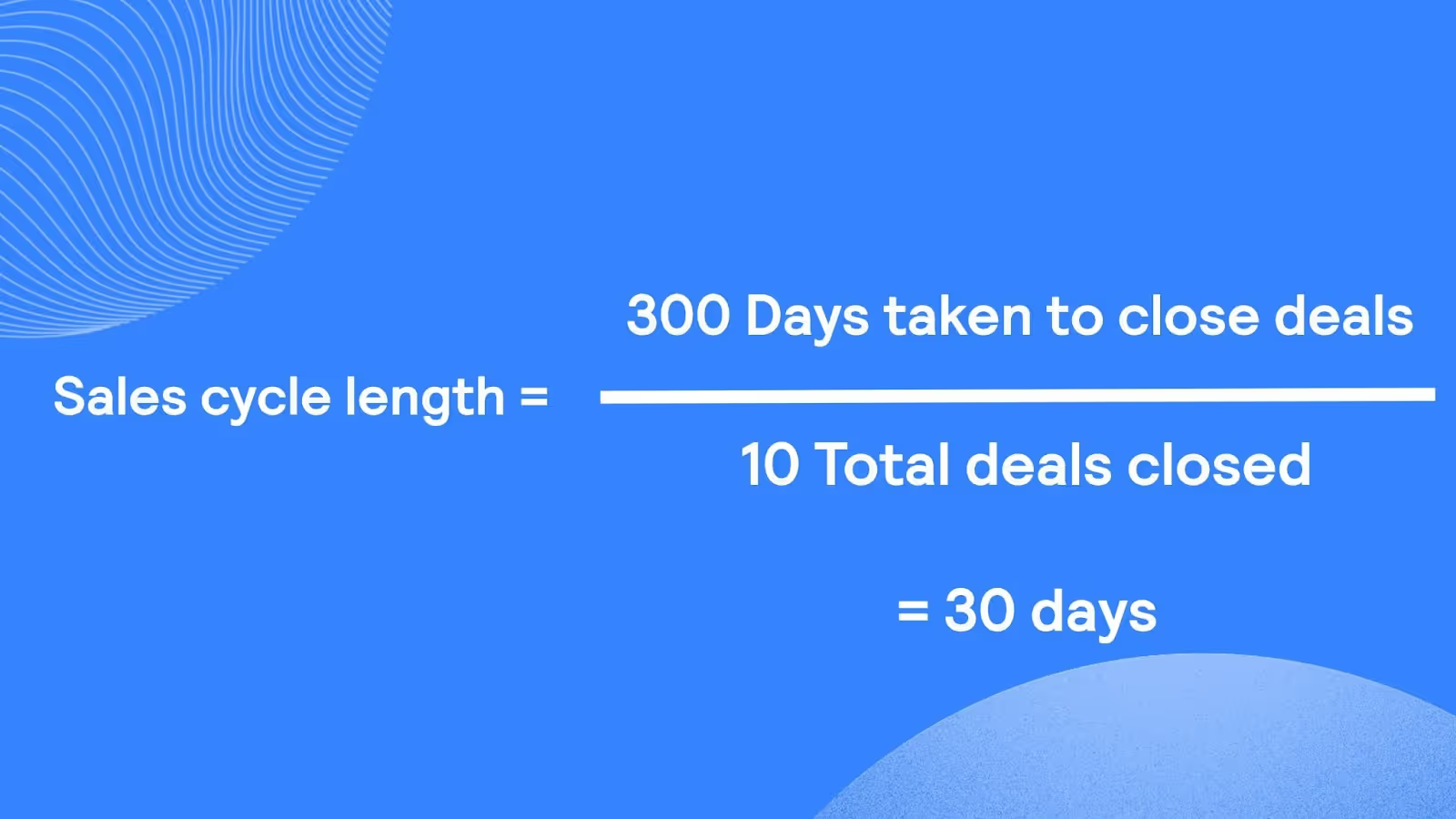
Product engagement metrics
Product engagement metrics are key for understanding how users interact with your SaaS product and the value they get from it. These SaaS KPIs provide a better look into user behavior, adoption, and overall stickiness. Let's explore each key metric.
28. Activation rate
Activation rate measures the percentage of users who complete a defined set of initial actions or milestones within your product, indicating they have started to experience its core value. Defining user activation milestones is crucial; these could include completing a profile, using a key feature for the first time, or integrating with another service.
Strategies to improve activation rates involve enhancing the onboarding flow, providing clear guidance, and highlighting the core value proposition as early on as possible.
How do you calculate your activation rate?
Formula: Activation rate = (Number of users who completed the activation milestone / Total number of new users) * 100%
For example, here’s how you’d calculate the activation rate if 1,000 new users signed up and 300 of them completed the key activation milestone:
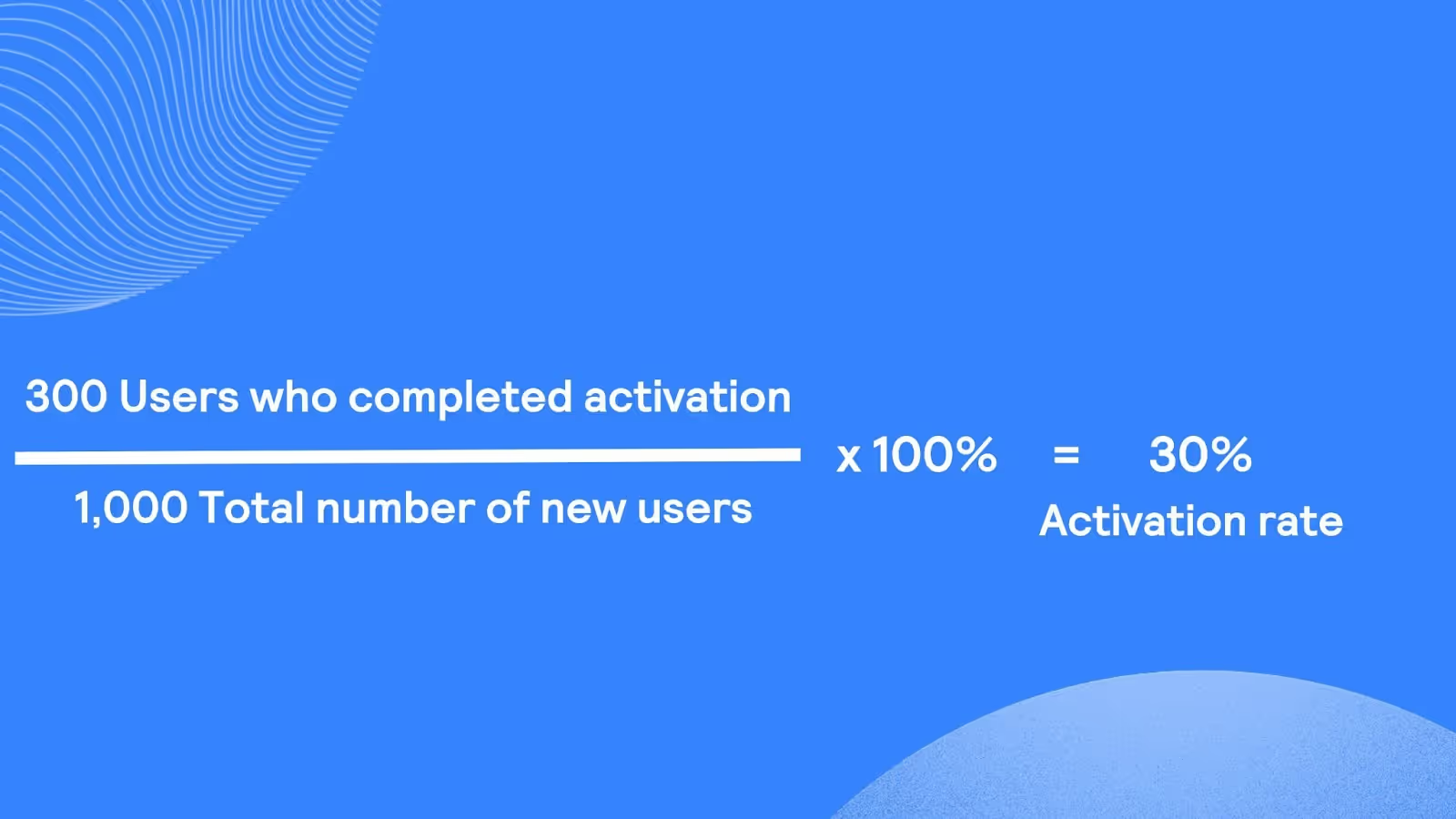
29. Product usage frequency
Product usage frequency assesses how often users are actively using your product over a given period. Understanding user engagement levels helps identify active users and potential churn risks.
Encouraging frequent product usage can involve highlighting valuable features, sending targeted reminders, and integrating the product into users' daily workflows.
How do you calculate your product usage frequency?
This metric is typically tracked using product analytics tools, which provide data on daily active users (DAU), weekly active users (WAU), and monthly active users (MAU).
30. Feature adoption rate
Feature adoption rate tracks the percentage of users who have used a specific new or existing feature within a defined timeframe. Measuring the adoption of new features helps evaluate the success of product development efforts.
Promoting feature usage can mean implementing in-app announcements, tutorials, and targeted communication highlighting the benefits of the feature.
How do you calculate your feature adoption rate?
Formula: Feature adoption rate = (Number of users who used the feature / Total number of active users) * 100%
Let’s look at this illustration below of the feature adoption rate calculation if you have 1,000 active users and 200 of them used a new feature within the first month of its release:
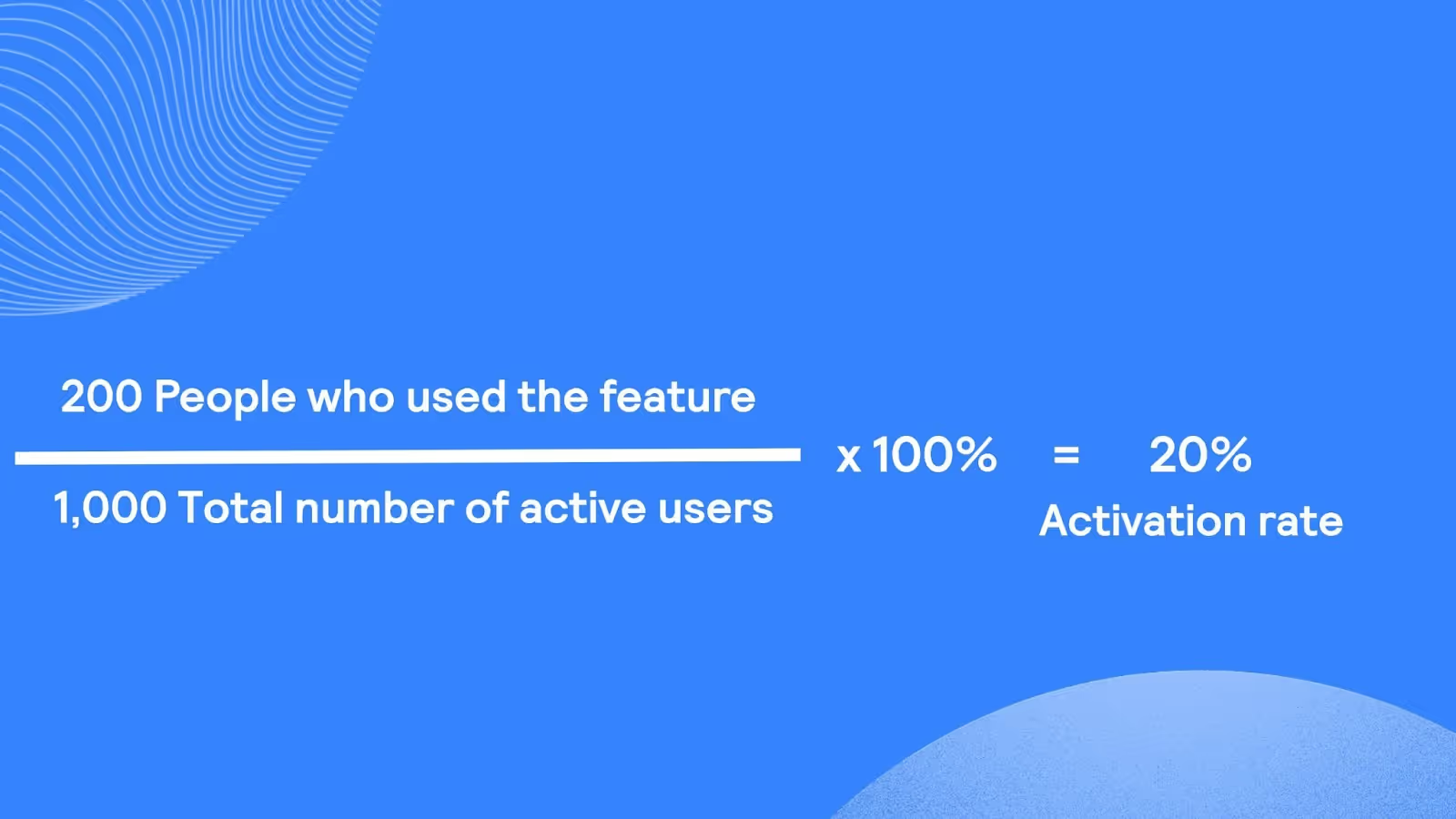
31. User retention rate
User retention rate measures the percentage of active users who keep using your product over a period. It indicates ongoing user engagement and is crucial for long-term sustainability.
How do you calculate your user retention rate?
Formula: User retention rate = ((Number of active users at the end of period - Number of new active users acquired during period) / Number of active users at the start of period) * 100%
For instance, use the illustrated example below to see how to calculate your user retention rate:
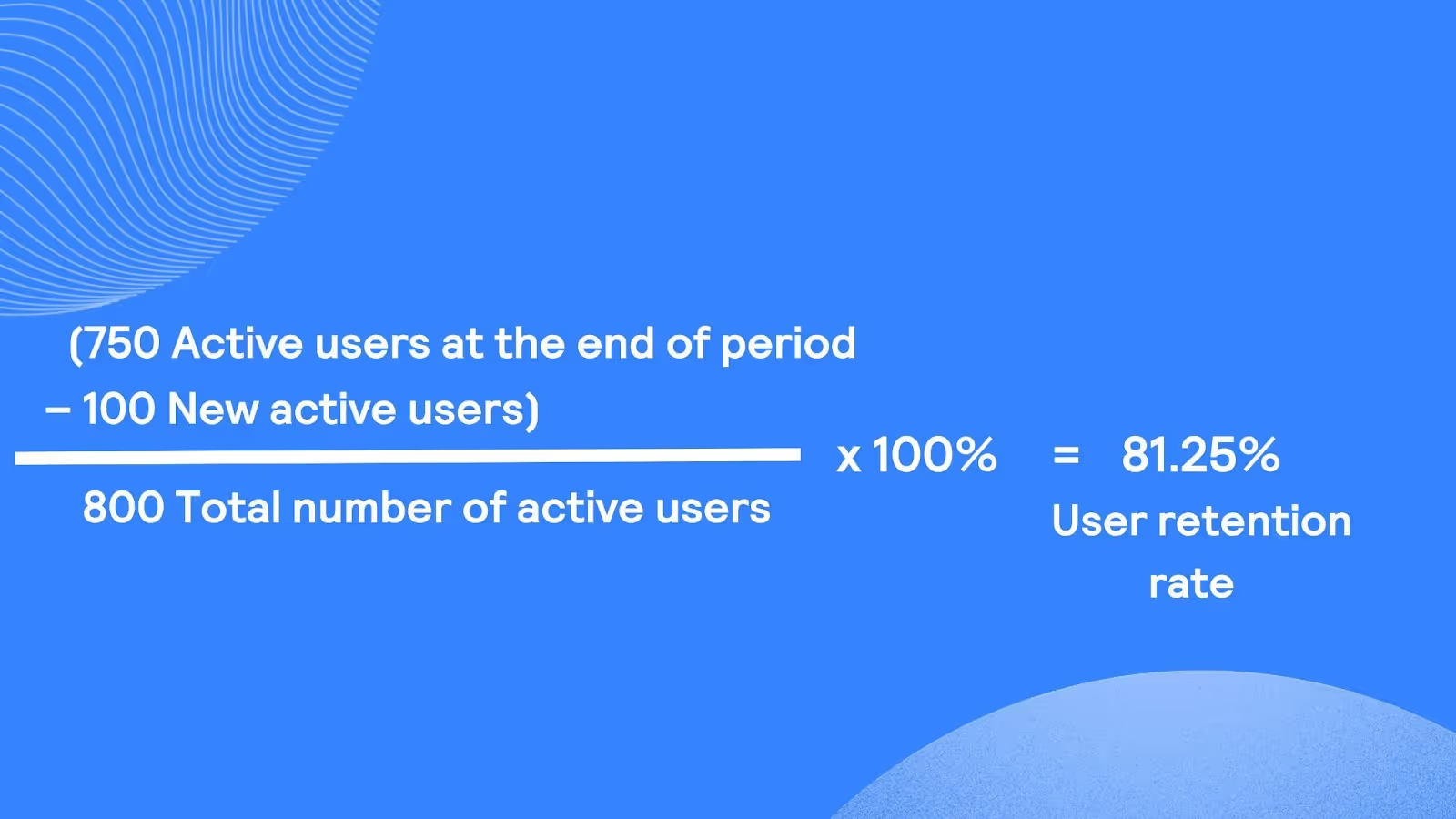
32. Customer engagement score
Customer engagement score is a composite metric that evaluates the overall level of customer engagement with your product. It often combines various factors like usage frequency, feature adoption, session duration, and interaction with in-app content.
Leveraging engagement scores can help pinpoint highly engaged users who are potential advocates and disengaged users who may be at risk of churn.
How do you calculate your customer engagement score?
There isn't a single standard formula for customer engagement score. It is typically a weighted average of several engagement metrics relevant to your business. You would:
- Identify key engagement metrics (e.g., login frequency, feature usage, time spent in-app)
- Assign weights to each metric based on its importance
- Track and normalize the values for each metric for each user
- Calculate a weighted average to get an overall engagement score
Customer support metrics
Customer support metrics are vital for gauging the responsiveness of your support team. These SaaS KPIs directly impact user satisfaction and retention. Let's examine each key customer support metric.
33. Customer support ticket volume
Customer support ticket volume is the total number of new support requests submitted by customers within a specific period. Determining trends in support requests can highlight recurring issues or areas where customers need more assistance.
Reducing ticket volume often involves active support measures like improving product documentation, creating helpful FAQs, and making the overall user experience better to prevent issues.
34. First response time (FRT)
FRT is the average time it takes for a customer support agent to provide an initial response to a customer's support request after it has been submitted. The importance of quick responses in user satisfaction cannot be overstated.
Techniques to reduce response times include improving agent workflows, using canned responses for common issues, and guaranteeing adequate staffing levels.
How do you calculate your first response time?
Formula: First response time = Total time taken for first responses / Total number of tickets
For example, here’s how to calculate it if your team responded to 100 tickets and the sum of all the first response times was 50 hours:
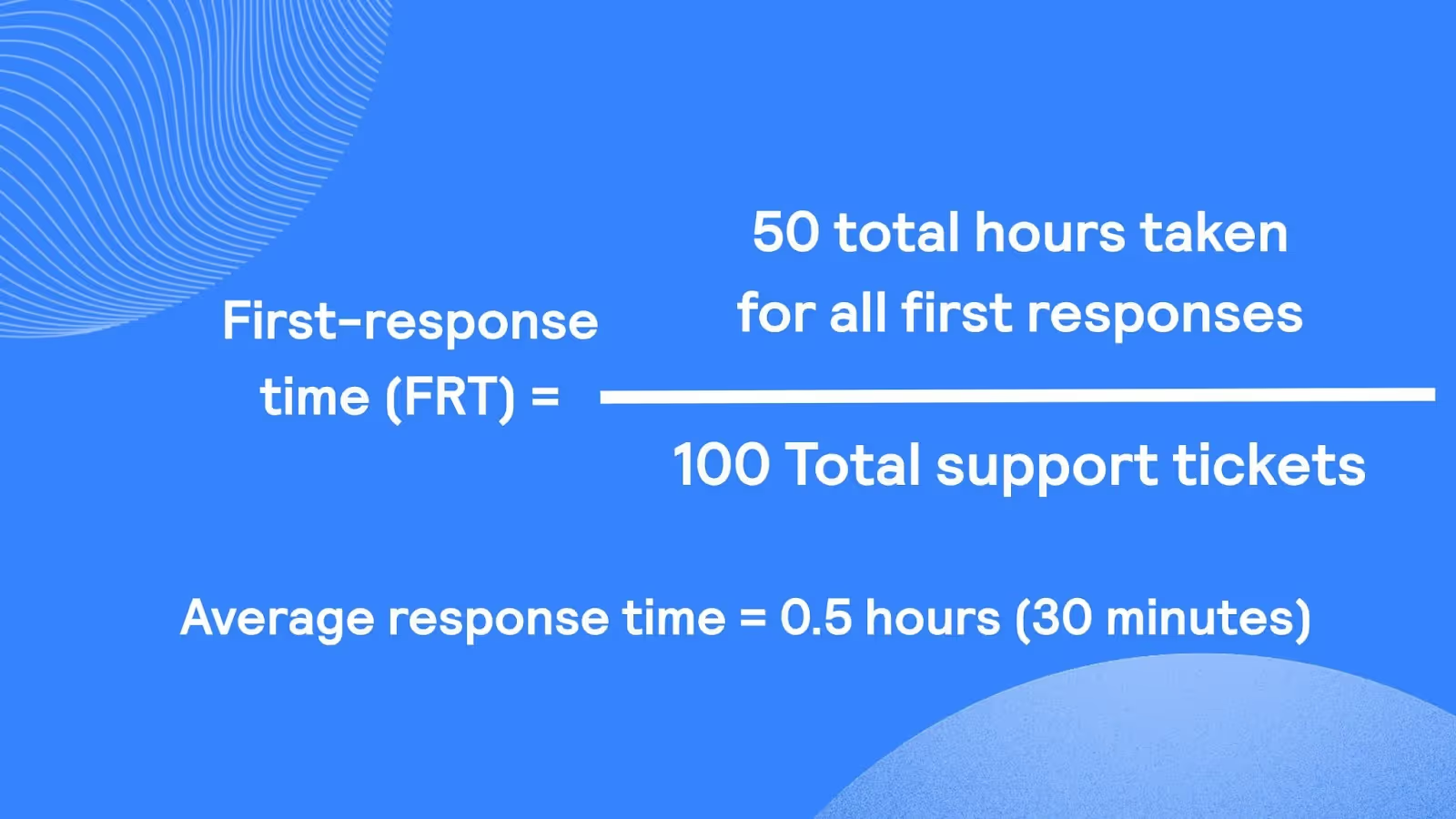
35. Resolution time
Resolution time, also known as average handle time, measures the average time it takes for a support ticket to be fully resolved and closed. It indicates the efficiency of your problem-solving process. Ways of expediting issue resolution include providing agents with adequate training and resources and implementing clear escalation paths
How do you calculate your resolution time?
Formula: Resolution time = Total time taken to resolve tickets / Total number of tickets resolved
Here’s how the calculation looks if your team resolved 80 tickets and the total time spent on resolving them was 200 hours:
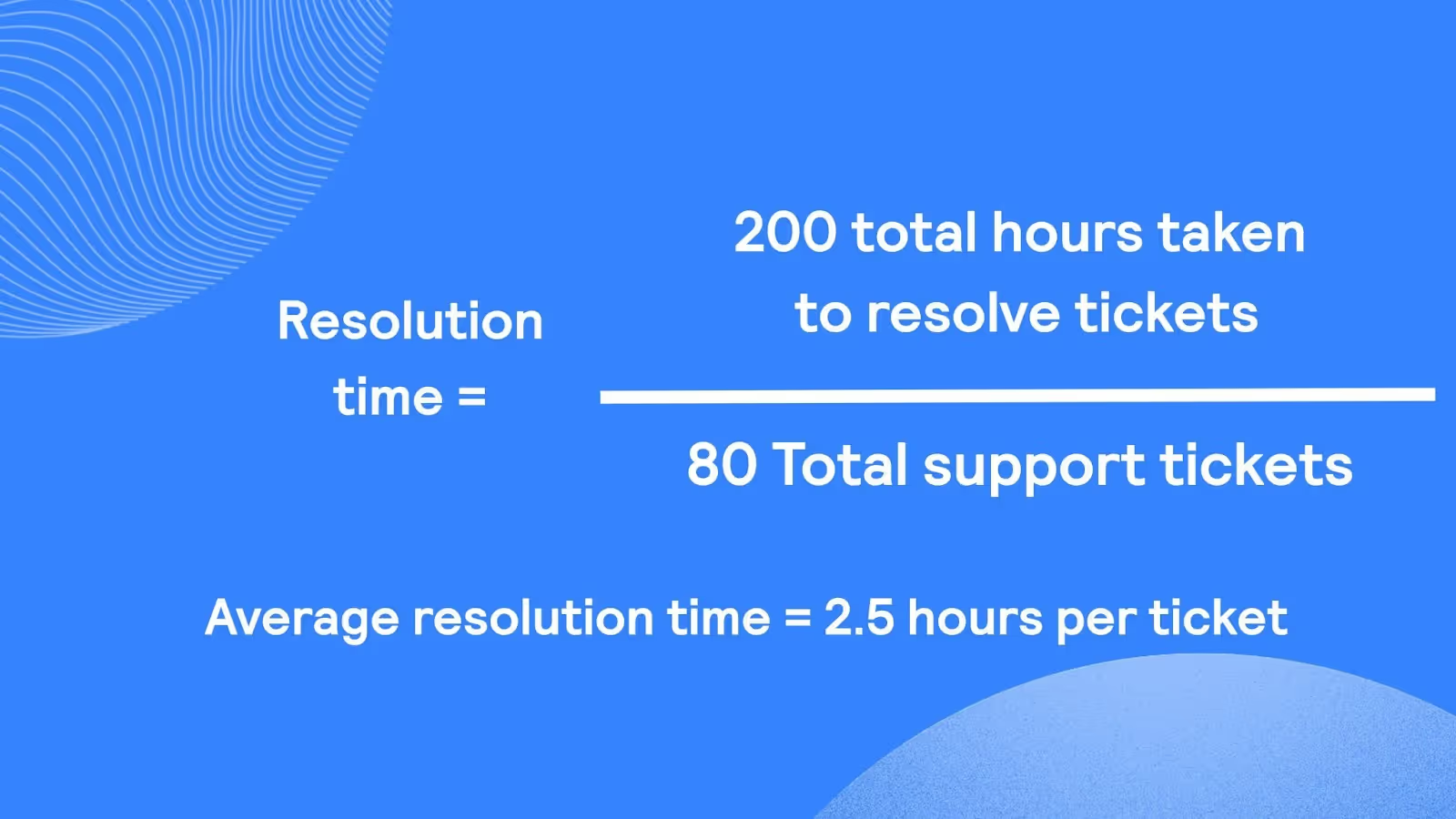
From SaaS KPIs to actionable billing with Orb
You've now explored 35 key SaaS KPIs and metrics that can help boost your SaaS growth in 2025. However, understanding these metrics is only half the battle. What if you had a platform that could unlock the power of your usage data, enabling you to act decisively on these insights?
That's where Orb comes in.
Orb helps SaaS and GenAI companies unlock their usage data, enabling flexible pricing, seamless billing, and faster growth, without the constraints of rigid billing systems. Here’s how Orb helps you turn your understanding of SaaS KPIs into tangible growth:
- Adapt with agility: You know agility is key to growth. Orb RevGraph and Orb SQL Editor allow you to quickly implement new pricing models based on simulations that use historical customer usage data — the very data that informs many of your crucial SaaS KPIs — without needing engineering resources.
- Price with precision: Accuracy in billing directly impacts revenue and trust. Orb RevGraph ensures precise, error-free billing by ingesting and processing all your raw event data. This accuracy extends to reflecting the nuances captured by your SaaS KPIs in your billing.
- Stop hallucinating on pricing with Orb Simulations: Before you commit to price changes that impact revenue (a core focus of many SaaS KPIs), test, optimize, and predict their impact with real data using Orb Simulations.
- Scale with confidence: Orb’s scalable API handles millions of events per second without dropping events, and built-in functions for billing, invoicing, and reporting — all built on top of your usage data — help provide frictionless operations as you track and act on your SaaS KPIs.
- Gain a trusted partnership: Implementing and tweaking your pricing models based on SaaS KPIs can feel daunting. Orb acts as a trusted guide, offering expert support and best practices to secure your success with usage-based pricing.
Ready to start using info from these metrics to drive flexible pricing, accurate billing, and faster scaling? Find the perfect plan to unlock your SaaS growth potential with Orb.

.avif)

